#hopefully this guide is comprehensive enough but feel free to ask me questions if you have any
Explore tagged Tumblr posts
Text
Hey, if you're in the US, it's tax season again!
Want to make it easy to deal with? And not pay someone else to do it for you? The IRS has continued to expand their free online services - if you live in any of these states (and don't have a more complicated situation), you can file directly with the government and cut out a lot of the cruft in the middle!
(That's almost half the country on-board now; if your state _isn't_ on the list, why don't you contact your governor and state legislature, and ask why they won't let the government money you spend on the IRS be used to provide government services for you...)

Go here: IRS Direct File
Also, not to get political, but this would be a great time to do your taxes early, and support your professional civil servants by taking advantage of the services they provide. There's too many assholes out there who want to take it away from you, because they don't think the government should work for people; don't let them win.
(More below the cut, because I want to send out a simpler version with less of my personal commentary. :)
Now, story time - this was available for me last year and I didn't use it; had a lot of stress going on and so just paid online for one of the big companies that I've used for years to file my taxes, because it was simple and what I already knew how to do. But this year, I wanted to give it a shot, and I thought it'd be useful to report back on the experience.
First thing you need to do is verify your identity; in my case a photo of both sides of my drivers license (other documents like a passport were also an option), and a brief video of my face. I gave them my phone number, and was texted a link that hooked in to my in-process filing so that I just took the pictures directly. Pretty simple, and the rainbow colors on the video were a nice distraction from seeing an unshaven early-morning version of myself. :)
Next was the time to fill in my forms. This is where I should say that there are still some situations where you'll have to do it another way:

You don't have to be from Illinois - I just am, so that's what it'll say here because I screen-shotted this as I went. But notable things they can't yet support are if you moved between states during the year, if you have self-employment or business income, any rental income, or any cryptocurrency income. (Hopefully these will be coming eventually; would love this to be as comprehensive as possible.)
I had to fill in the information from my W2 and assorted forms; there was a note about possibly pulling it directly from my employer's filing, but it wasn't working for me. OTOH, I wasn't able to upload the PDF last year with my paid tax preparation either, so nothing lost there.
Actually, overall it was I think smoother than the service I paid for - a series of check boxes and forms guiding me where to look for what numbers to type in; some complicated questions because the tax code is complicated, but as good an explanation from the IRS as to what it meant as anyplace else. Additionally the IRS doesn't feel the need to add flashy animations or advertise other paid services I might want to engage with, so I never had to fight the feeling that maybe it would be easier if I just gave them another $75. Love to just engage with a service that my taxes have already paid for.
All told, took maybe 30 minutes, at least half of which was setting up and verifying my account with the IRS, which I won't need to do again next year. Then another 10 minutes for my state taxes, which the IRS couldn't do directly for me, but _did_ have a helpful link to my state's free online filing and auto-filled out as much as they could.
Anyway, all told can't recommend this enough. If you have baseless tax anxiety, it's professional, simple, and free - what more could you ask for?
(If you have a basis for tax anxiety, I can't help you, sorry. I am not a tax lawyer, or any sort of government professional. :)
#IRS#taxes#US government#Direct File#IRS Direct File#free tax filing#I support getting the government you paid for and deserve#If you're not in the US I hope your taxes are simple and easy this year too
0 notes
Text
Papercraft Crafting Guide
Welcome to the Papercraft Crafting Guide! As you’ve probably seen on my blog before, I’ve created a papercraft template to make a small 3D model of Sky from Linked Universe and since you’re here, I’m assuming that you want to make your own 3D model, too. Whether you have some experience in creating papercraft figurines or are completely new to the subject, I have created a comprehensive guide down below that’ll take you from the first step all the way to the last.
First things first, you’ll need to save the template that is provided for Sky by right - clicking on the template and saving the image. Due to how strangely Tumblr condenses and uploads images, you may need to open the template in another program like MS Paint or 3D Paint for Windows users or Paintbrush for Mac users before printing out the template, just to make sure the template gets printed on the whole page like so:

The template is designed for A4 printer paper, or a standard 8.5″ x 11″ paper, so keep that in mind as you resize the template as needed.
Next you’re going to want to gather your materials. After you’ve printed out the template, you’re going to want to grab a pair of scissors, glue (could be your typical Elmer glue, craft glue, a glue stick, etc.), and maybe a small thing to spread out the glue like a Q - tip or toothpick. The thing about making papercraft models is that you have to be sparingly with your glue: you only want to use as much glue as you need, or else you run the risk of soaking the paper and tearing apart the model; so that’s where the Q - tip / toothpick / whatever comes in: use your tiny tool to spread the glue across the folds to make sure there’s not too much in one spot of the figure, and to also save you the hassle of using more of your supplies than you need to.
Now that that’s out of the way, you can start to cut out the pieces of your template. How you cut out your template is completely up to you: you can cut out one piece, glue it together, set it to the side, and then work on cutting out the next piece, you can cut out all the pieces at once and then glue them all at once, you can cut out all the pieces that are needed for the head and glue that, and then work on the body - really, whatever works for you. No matter how you decide to cut it, this guide is going to go through crafting each piece one - by one.
Head Pieces:
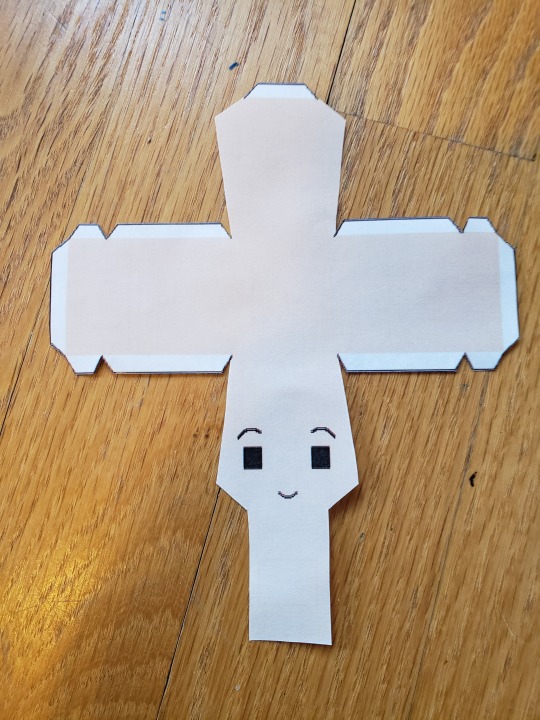
When you cut out the head / face, you’re essentially going to be left with a plus sign - ish shape. Once that’s done, you’re going to fold the pieces inward (from the front of the papercraft to behind) along the green lines shown below with the white tabs already on the template there to guide you on how far to fold in:
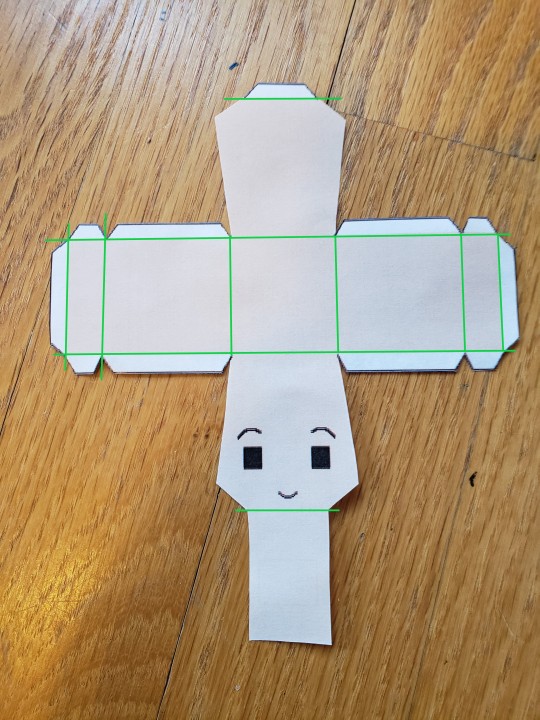
In the end, the head should be folded in this shape:

Next, you’re going to glue around the white tabbed pieces and stick them to the place they’re sort of parallel to. Below are green arrows to show you to where each white tab should go for the front of the face, and don’t forget to glue in the same way to the back of the head:
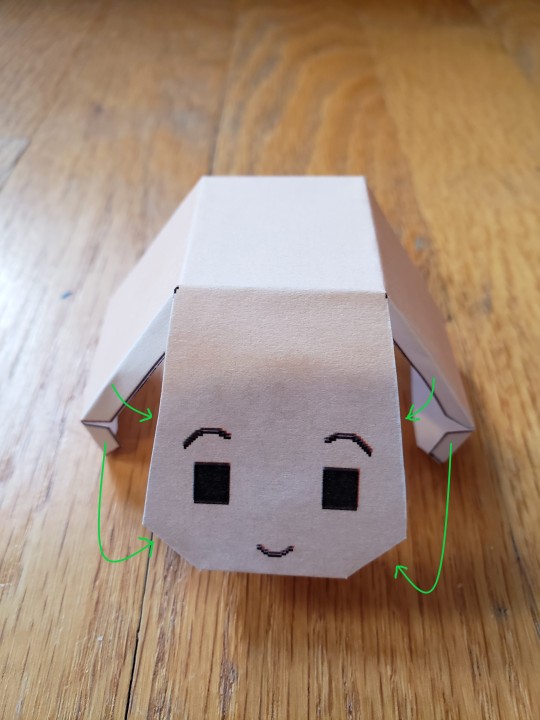
Once you’ve glued the front and the back of the face, you’re going to want to tackle the very bottom of the head. If you turn the head upside - down, you’ll notice that there’s a long flap along with three tabs; you’re going to want to spread some glue on those white tabs and then fold the long flap piece over, successfully sealing off the hole:

Flip the head rightside - up, and you’ll be done with the face piece! You can set that piece off to the side to let it dry:

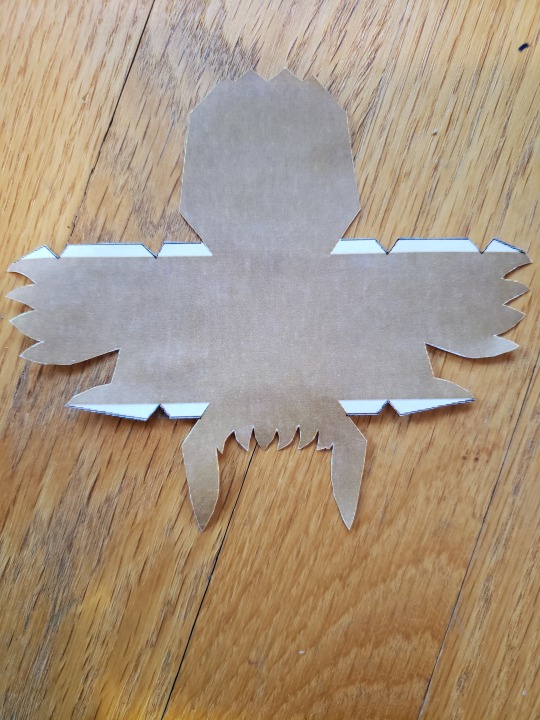
We’re going to tackle the hair next, and you’re going to fold along the green lines just like last time:
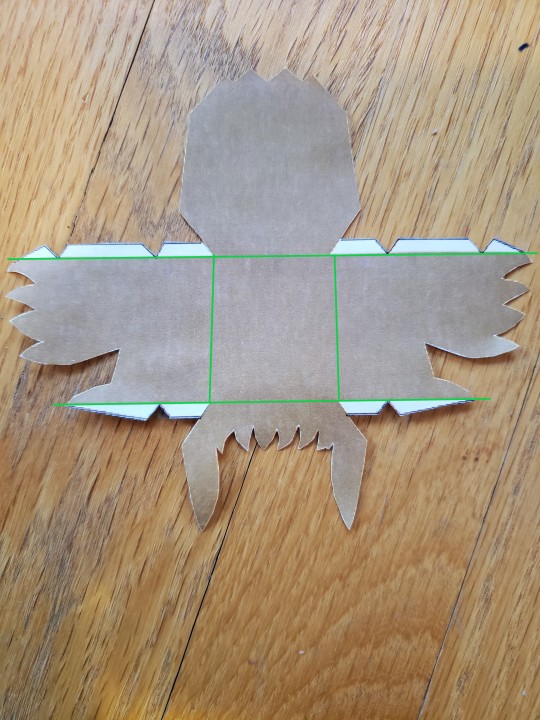
The folded ending result should look like this:
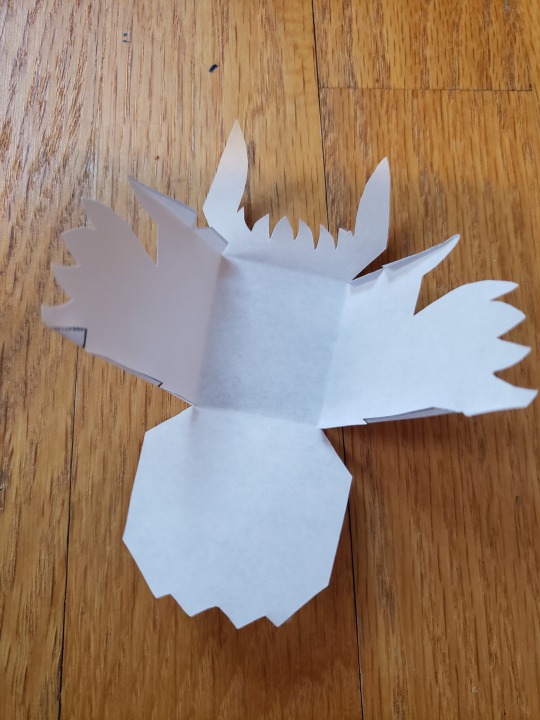
Glue on the white tabs just like before. I added some arrows just to make the instructions a little clearer:
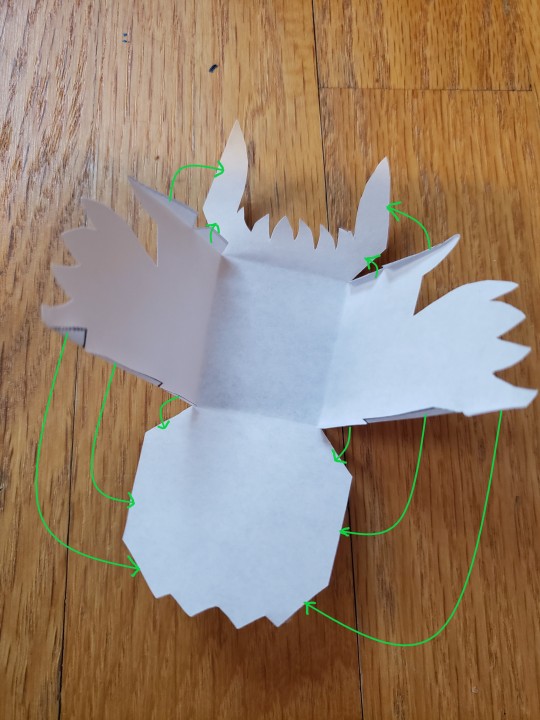
Once it’s all glued together, the ending result of the hair should look like this:

Now this is the part where you can deviate a little bit. Once the glue on the hair is all dried, you either have the option of gluing the hair onto the head immediately, or gluing the hair once you finish building all the other pieces. For the purposes of this guide, we’re going to glue the hair onto the head now. Remember to be generous with the amount of glue you put on the top of the head:
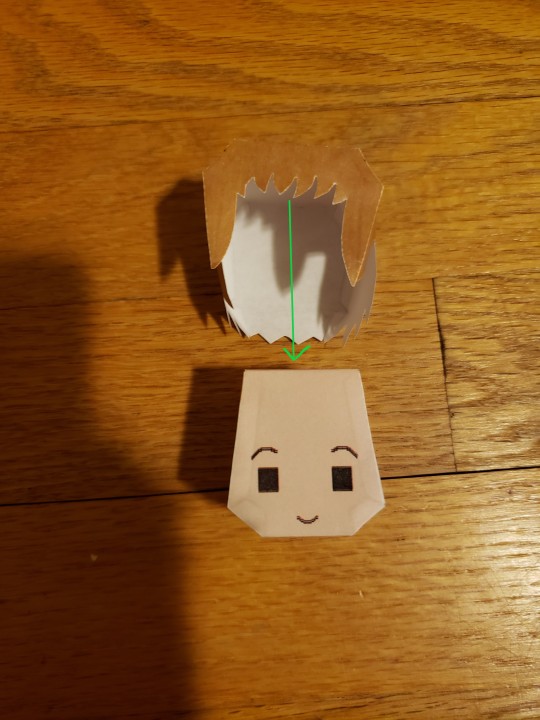
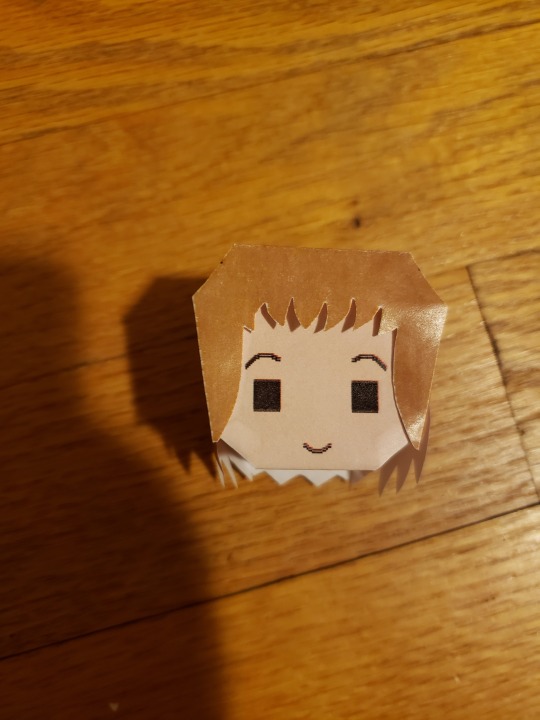
After the hair is glued on, you might want to consider leaving the whole head off to the side, upside - down, just to make sure that gravity does its job and makes sure that the top of the head is being glued to the top of the hair. Next up is the body!
Body Pieces:
So the body pieces typically consist of three things: the actual body, the arms, and the legs. Since we can’t really attach the arms and the legs without the body, we’re going to start out with the body first.
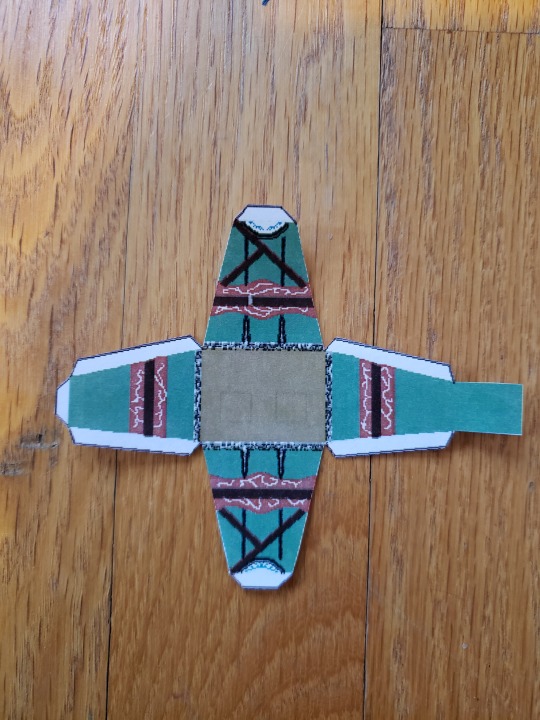
Just like the head, the general shape of the body is a plus sign, with the rectangle in the middle being the very base of the body and also where the legs get attached. First off, we’re going to fold along the green lines:
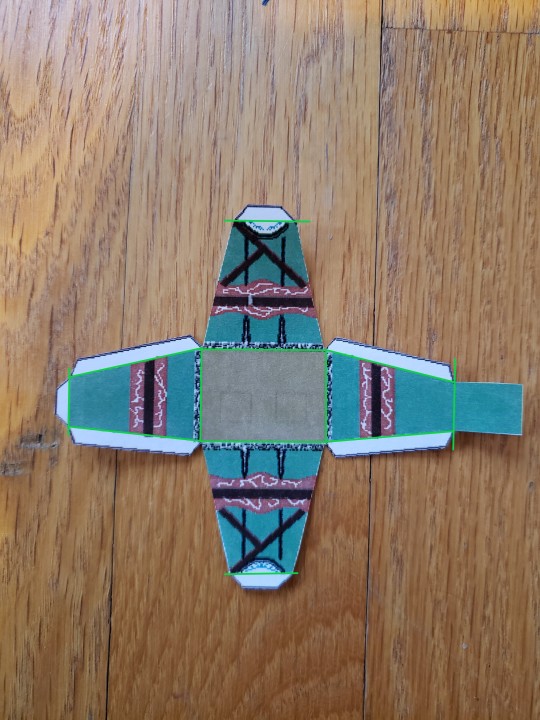
With your ending result looking like this:
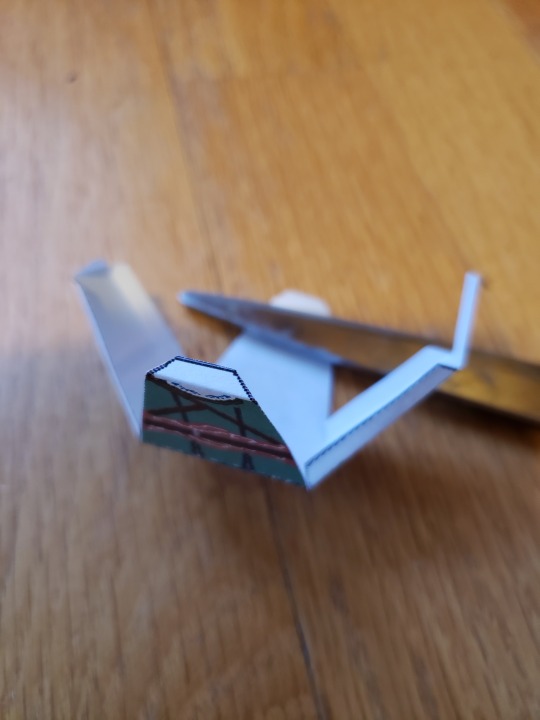
Next up, we’re going to glue along the white tabs and match it up with their respective placement on the front and the back of the body. Down below are some arrows to help guide you where to glue:
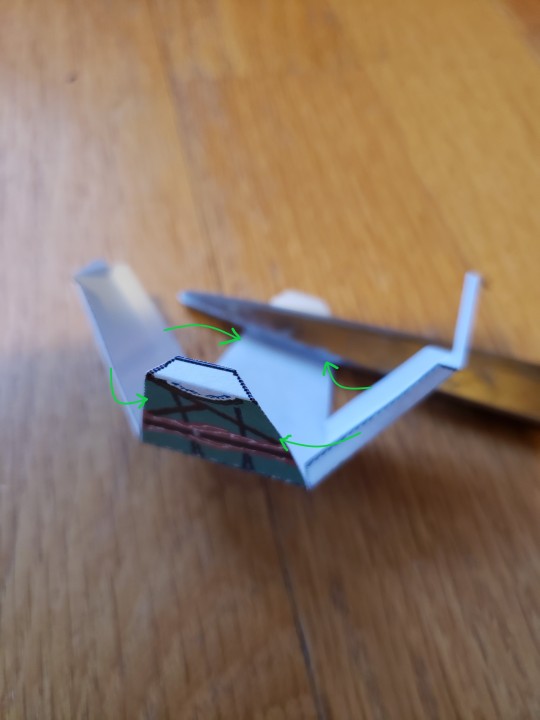
Once you’ve glued all the sides together, you’ll be left with a sort of rectangular shape for the whole body as well as an opening for the top of the body. Remember how we were left with three white tabs and a long flap at the base of the head before? Well it follows the same gluing rules just like before! Add some glue to the three white tabs at the top of the body, and then fold the flap over to close up the hole in the middle:
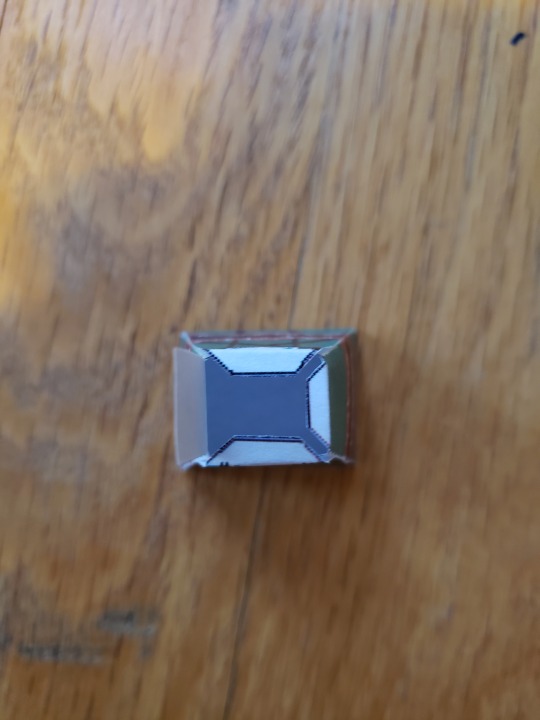
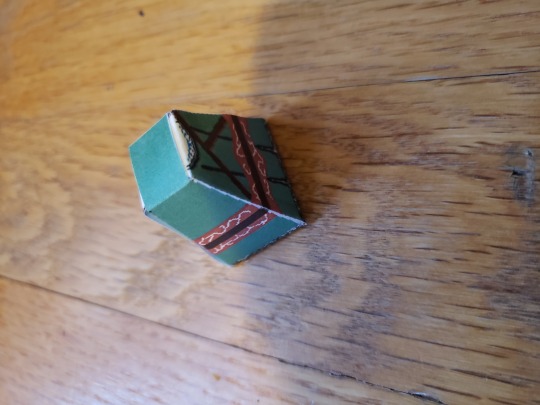
That part of the body is done, so now we can move onto the four remaining pieces! For the legs and arms, it really doesn’t matter which order you cut them out and glue them; they’ll all be going on the body in the same step, so it’s your choice on whether you want to create the arms or the legs first. For the purpose of this guide, we’ll be creating the legs first:
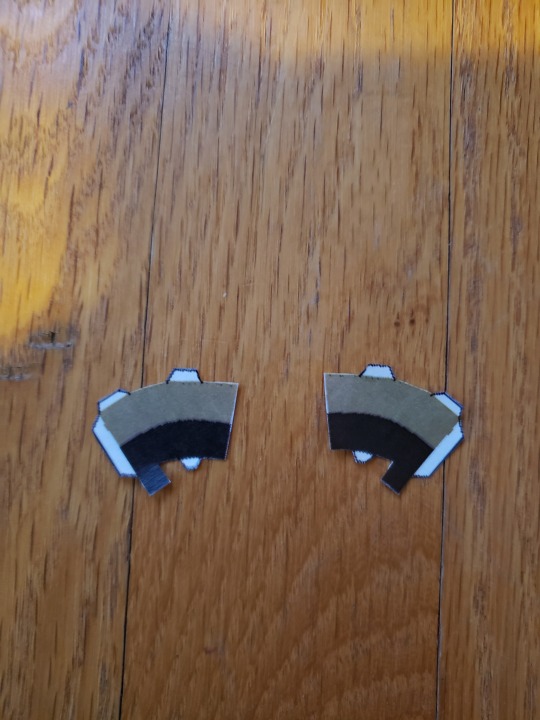
When cut out, both the legs will look like this. Make sure to keep tags on which leg is which to make sure that the papercraft model can be perfectly balanced in the end. If you think you might have a little trouble remembering, you can write an ‘L’ and a ‘R’ on the back of the legs in order to signify which leg represents which side. When that’s all done, you’re going to fold along the green lines on each leg like so:
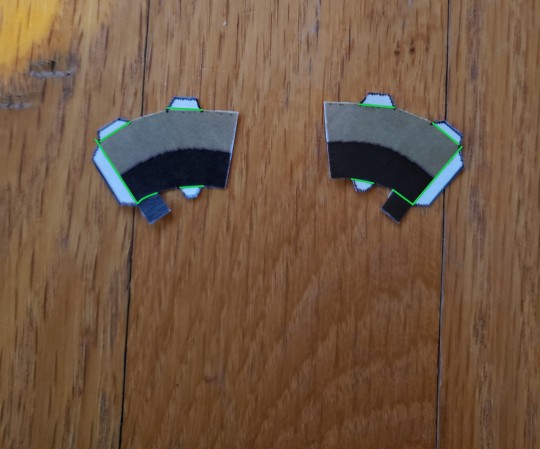
In the end, your folds should look like this (showing the back side of the legs in order to see the tabs better):
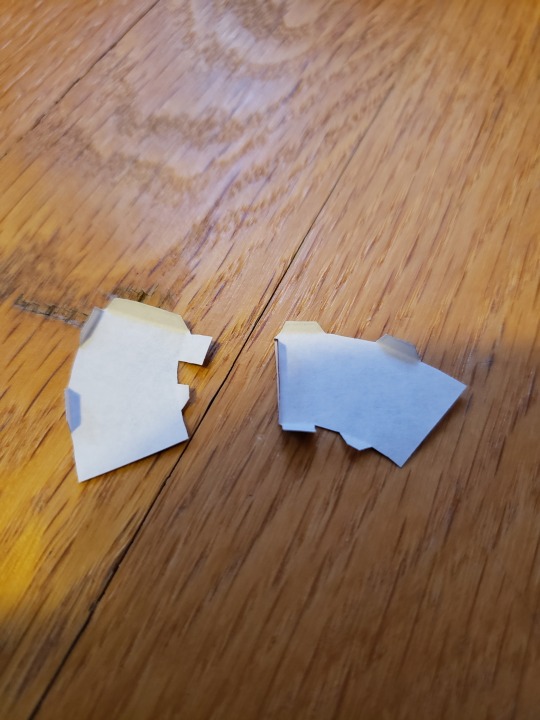
Next up, you’re going to curl each of the legs inward to make a cylinder shape and glue the longest white tab to its parallel counterpart as shown by the green arrows (just showing one leg as an example of what to do):
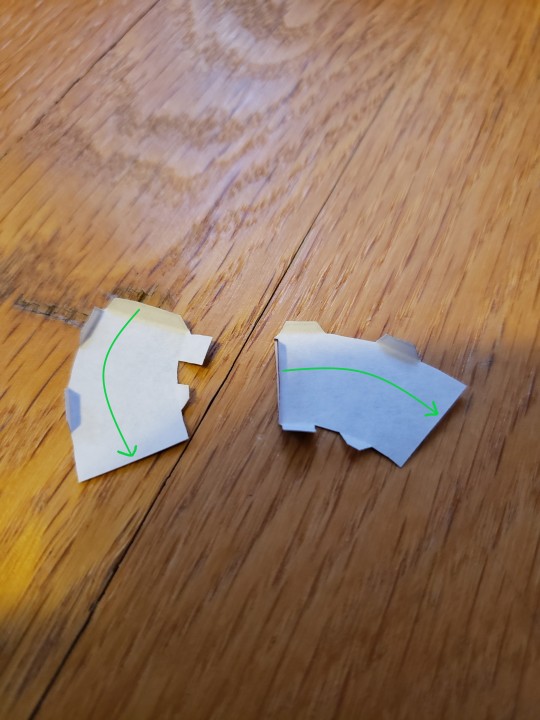
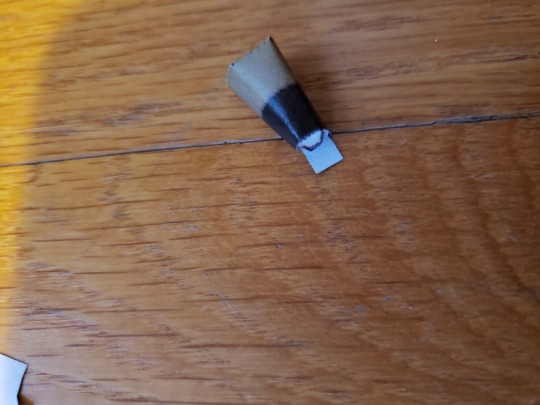
To finish it off, you’re going to close the little flap at the end by gluing it to the tab opposite of it and following the green arrow, just like we did with the head and body:
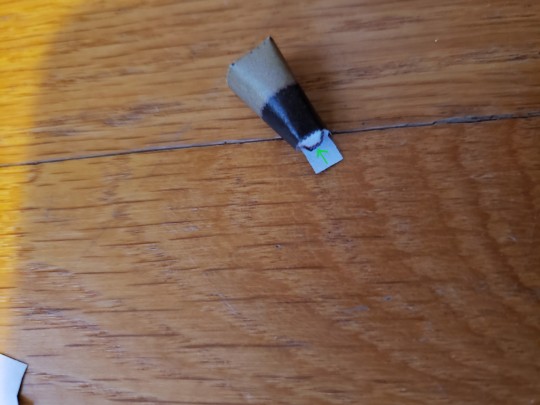

Awesome, you got two legs done! Now put those off to the side so we can work on the arms:
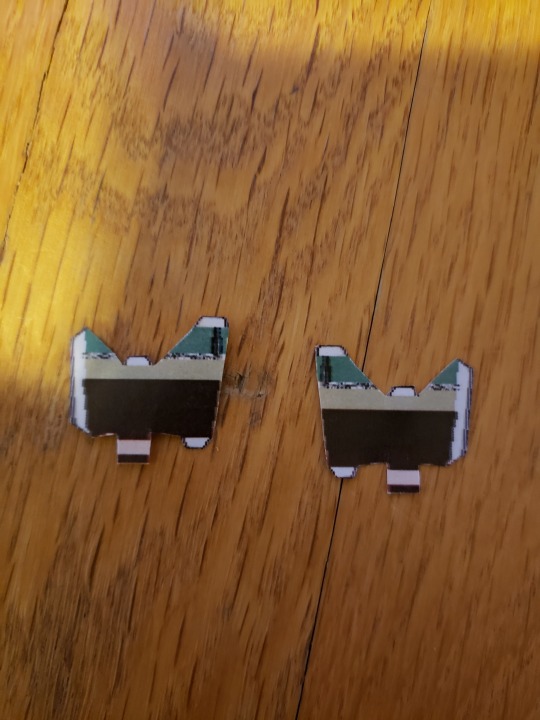
When cut out, the arms will look just like that, and just like before, you’re going to want to tackle it the same way like the legs: fold over all the tabs and the little flaps as illustrated with the green lines, connect the longer tab to the side of the arm that is parallel to it, and close off the little flap to each arm with its respective tab. Here’s a quick speedrun below:
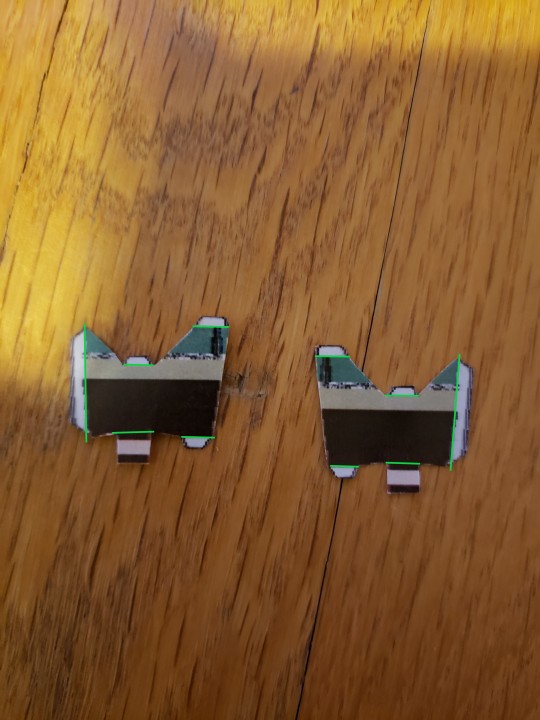


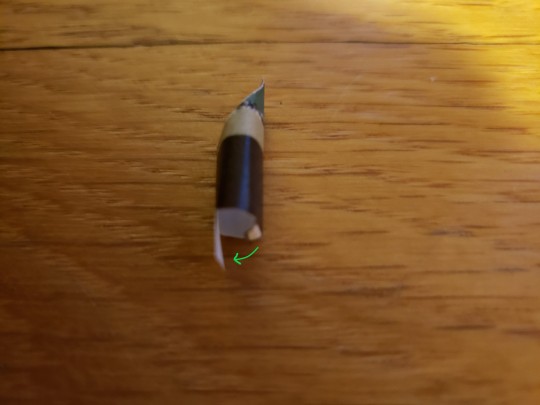
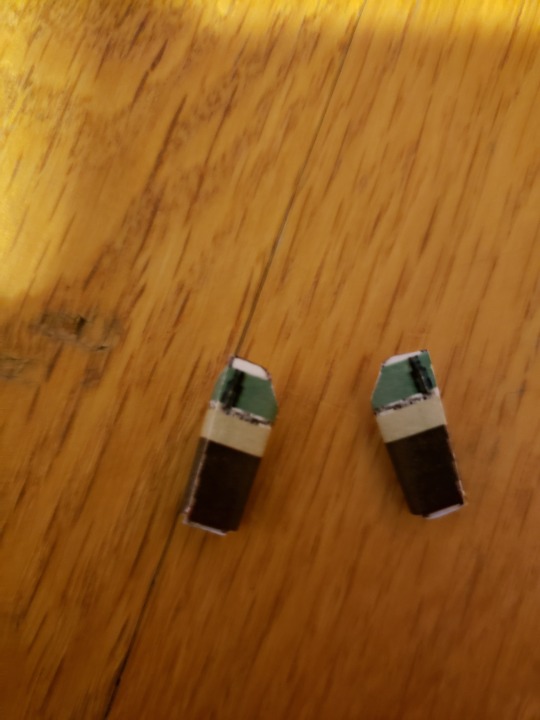
Woo, two arms complete! Put those off to the side and now with all the body parts complete, we can start to put the whole body together. Depending on whether you started with the arms or legs, you’re going to want grab whatever you made first along with the body. Since we created the legs first, we’re going to grab the body and the legs. We’re going to position our three items like so:
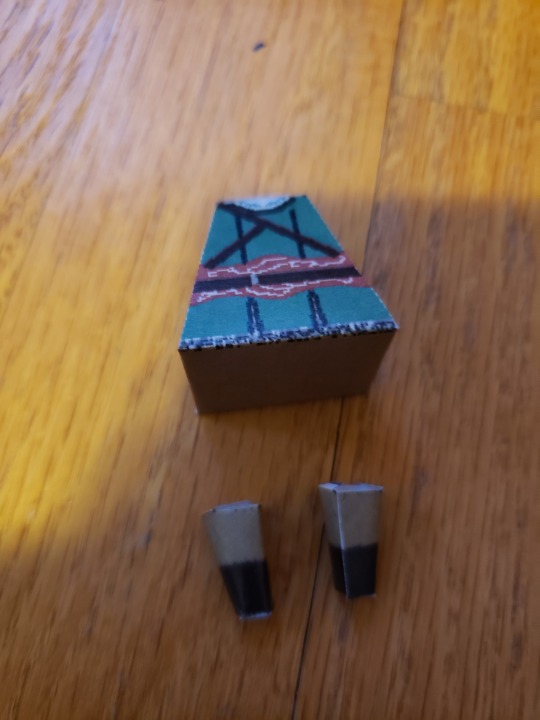
And glue the legs to the smaller squares on the base of the body. Remember, those two tabs on the bottom of each leg are there to make sure that the legs have a firm grip on the base of the body:
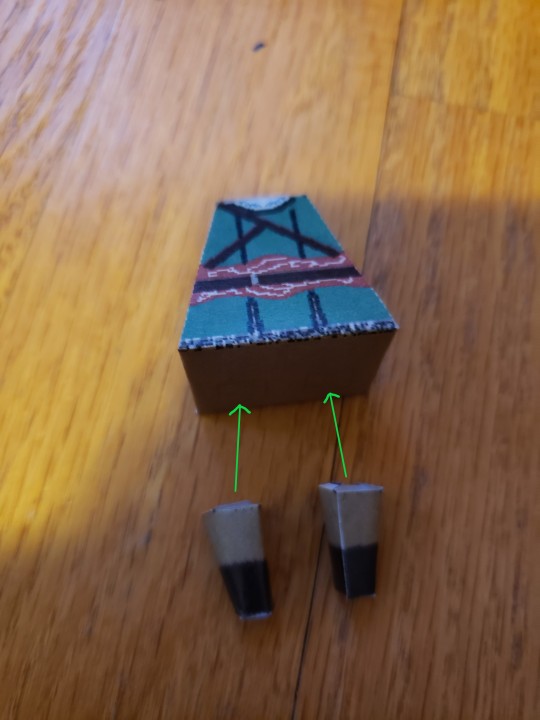
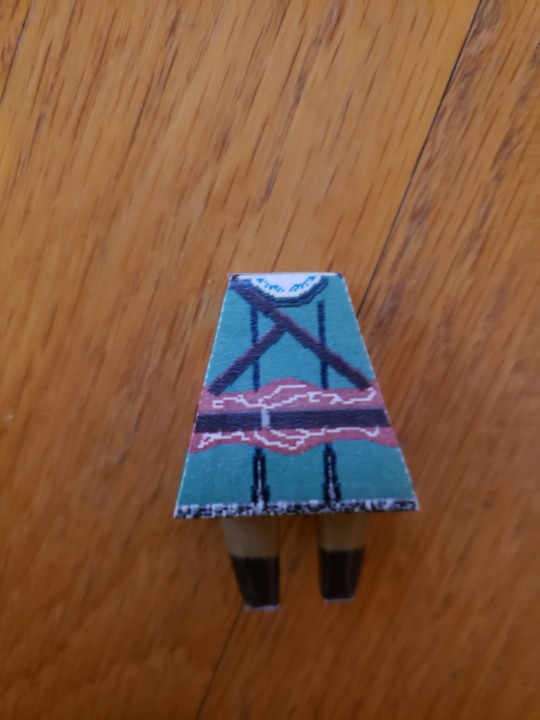
And once that’s all done, we can add the arms. Gluing the arms are going to follow the same pattern as the legs, but when you do get to that part, you’ll have to make sure that the arms are glued on right. The longer part of the arms are meant to go towards the top of the body while the shorter part of the arms are supposed to go towards the bottom of the body, giving the model the appearance of having shoulders. Below will be a little speedrun of what needs to be done for the arm portion of the body:

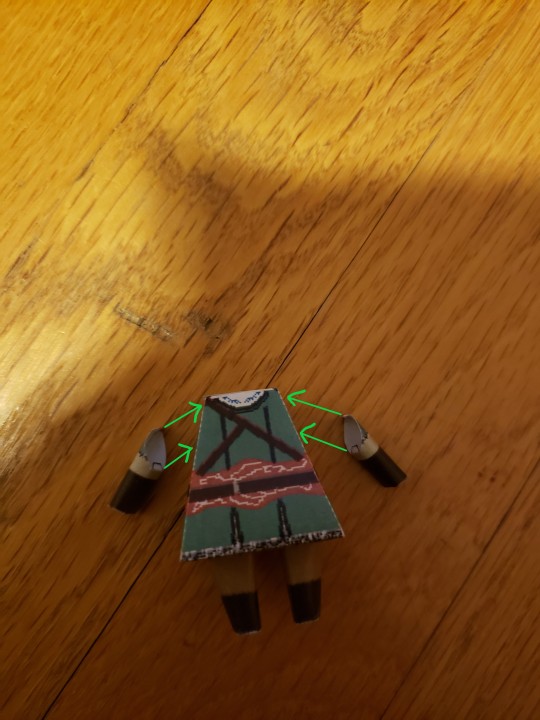
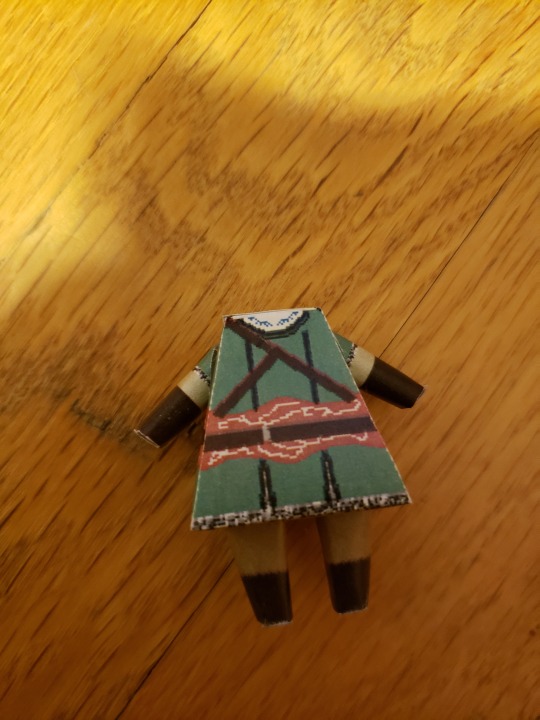
Woo! The body portion of the papercraft figurine is all done! Now set that piece off to the side so we can add any needed accessories.
Accessories:
Depending on the papercraft model, the figurine may come with a few accessories in order to account for any crucial details of that character. For the case of Sky, we’re going to add a sailcloth in order to give him that finishing touch. First, will start off with cutting out the sailcloth; however, be careful when cutting it out because the cream color of the sailcloth is very close to the white color of the paper, making it nearly impossible to see on first glance. My advice is: take your time, refer to the whole template on your computer screen in order to see the sailcloth better, and really pay attention to how far you cut. In the end, the final product should look like this:

Once that’s cut out, all you need to do is fold over the tabs as well as a small rectangle where the diamond resides in order to give Sky the illusion of having the sailcloth around his neck (the sailcloth is flipped over to emphasise the folds):
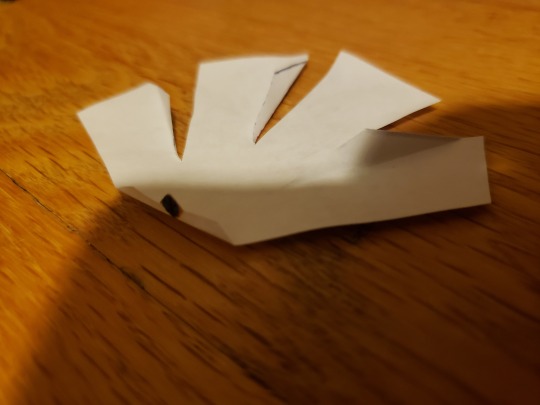
Now we’re going to glue the sailcloth together. Make sure to glue the tabs in a way where the final product will complete the blue design on the back:
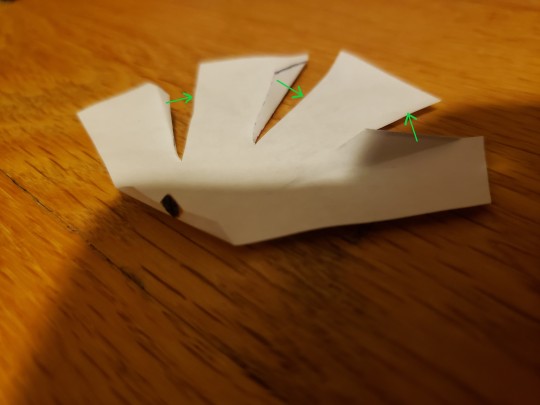
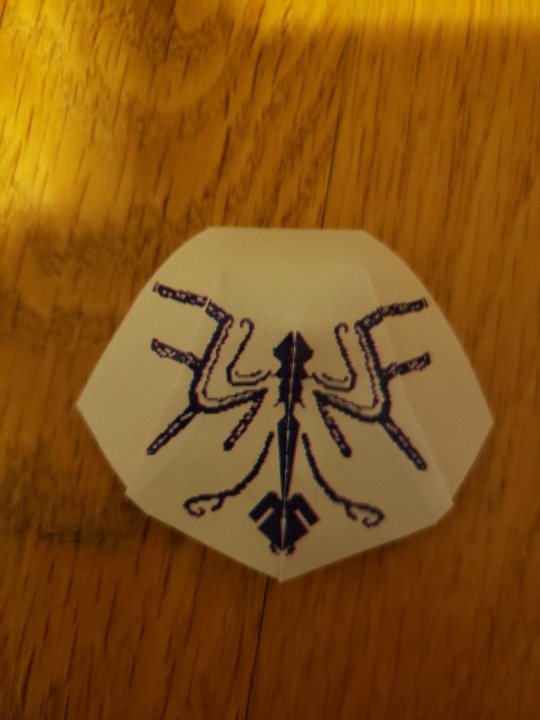
As you’ve probably noticed, the sailcloth already bends down due to the folds that you glued together, making it the perfect accessory to add to the final papercraft product!
Putting it Together:
Now that all our pieces are complete, all we really need to do is glue the whole model together. Let’s start off by positioning the papercraft like so:

And glue everything together like a sandwich:
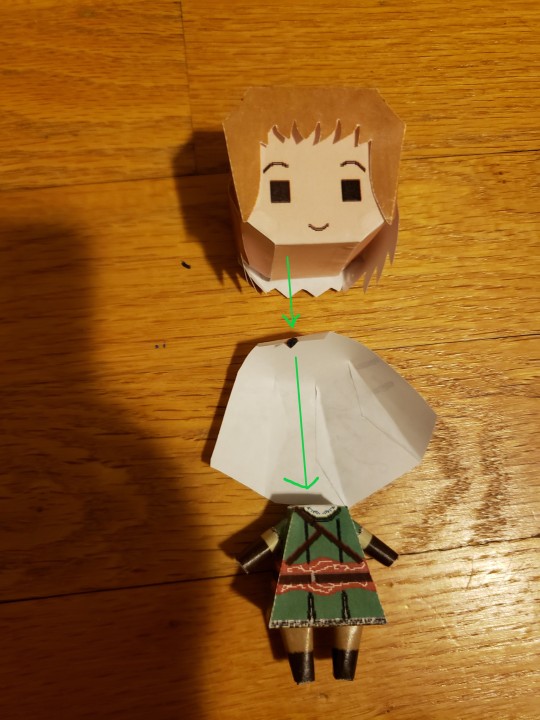
So your final model looks like this:

Congratulations! You finished your papercraft model! All that’s left to do is let it dry for a little bit by resting it upside down on its head like this in order to help it keep its shape:
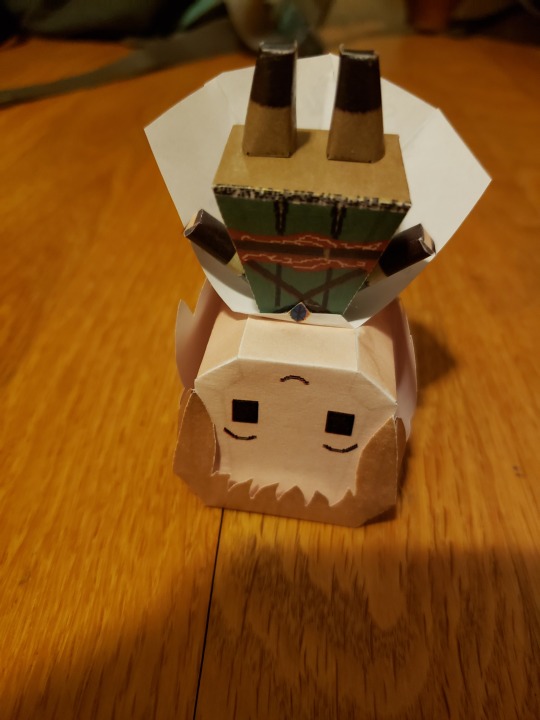
After ~5 minutes, your papercraft model should be all set to go!
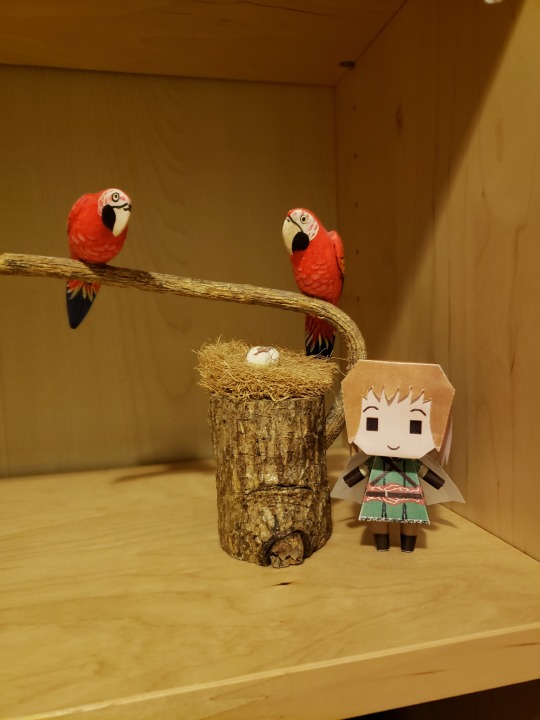
Optional:
You also have the option of making a little base stand for your model in order to prevent it from falling backwards all the time. In order to add that piece in, you’re going to cut out the part that says ‘base stand’ on the template, and glue it to the feet of your model like so:
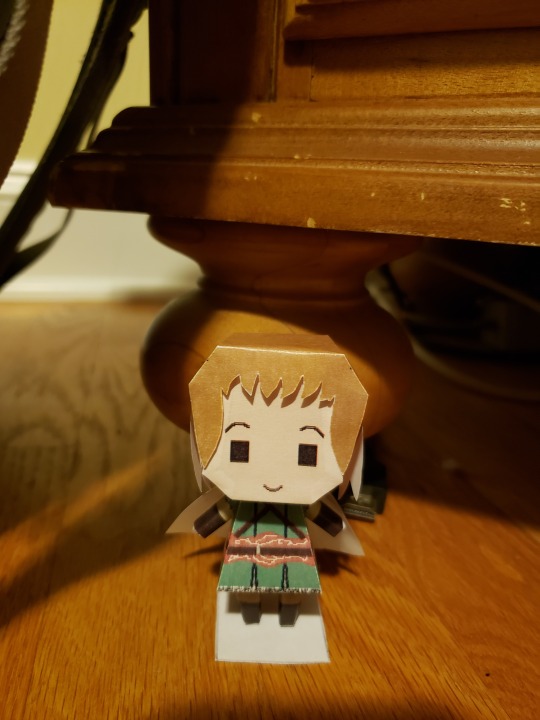
But, of course, this part isn’t necessary if you want your papercraft model to just be chilling without a stand.
#papercraft guide#creating these little things were like the staple of my childhood so i'm more than happy to share it all with you guys#plus Jojo makes the character designs so cool and unique so I honestly have a lot of fun designing the templates#hopefully this guide is comprehensive enough but feel free to ask me questions if you have any
9 notes
·
View notes
Text
My Top Korean Resources [2020 edition]
I have been discussing resources with a few people on private message and have been thinking a bit about what resources were the best on my journey.... so here’s my final (maybe) compilation of resources for the year that will hopefully be helpful for anyone who is looking at resources between the beginners and upper intermediate levels.
NB. This list is based off materials I have used in the past and is not an exhaustive list of ALL the resources I have used - it is just a selection of some of my favourite. There are so many Korean resources out there so there might be some that work more for you that I haven’t even looked at.
Course Texts
In my opinion, the perfect course text isn’t going to teach you everything you need to know, but a good course text will at least give you a clear framework to chunk up and guide your studies. I have used a few but the most user friendly one is definitely:
Talk To Me In Korean - they set things out clearly so nothing feels overwhelming and provide a sensible framework to follow for self-study. Other course books tend to be better suited for in-class settings and not great for self-study.
Grammar
The course texts will teach you about grammar but I think they don’t teach you how the grammar structures are related to each other. So I think it is key to look at one or more of these books:
Korean Grammar In Use: Beginners
Korean Grammar In Use: Intermediate
The above series is incredible and a serious MUST for all Korean learners. They clearly and concisely set out the grammar points and show how they are all related to each other. There is an Advanced book as well which I have yet to use and will teach quite complex structures.
Basic Korean: A Grammar and Workbook (I have linked the forthcoming version being released in Dec 2020!)
Intermediate Korean: A Grammar and Workbook
The above Routledge series is great for its workbook feature. The layout is a little academic so it’s not super appealing but the way they explain grammar is clear and relatively detailed. The number of examples included in the workbook is fantastic, providing a lot of opportunity to practice. I haven’t used the Basic book but if it is anything like the Intermediate, it will be a winner.
Vocabulary
The part that people often miss out when learning Korean is vocabulary, because it can be so easy to just follow course texts and grammar books, but those will never teach enough words. To learn more vocab, it is really important to read around. There are so many Korean language books that you can pick up, but here are some books and resources that are catered specifically for language learners that I have loved:
Korean Culture in 100 Keywords - they give a paragraph on different cultural aspects of Korea in both Korean and English and highlight all the new vocabulary for you. The texts are graded from easy to more difficult.
News in Korean - lots of short news stories with translations in English and comprehension questions. Might be targeted more at intermediate learners
Mind Map TOPIK VOCA 2300 - this book sorts vocabulary into categories and shows them as mindmaps. It also gives readers sentences in context and has mini quizzes, HOWEVER it is written in 98% Korean so this is a book that is definitely more pitched at upper intermediate levels and above and teaches vocabulary that is a little less common
Anki - my most used resource. Everyone has their own favourite for flashcards and this is mine. Anki do spaced repetition meaning that it will constantly test your knowledge on vocabulary, spacing the quizzes/tests depending on how difficult you find the word. It is more efficient than other flashcard platforms, but it is a little tricky to get started and create your own cards. If you want to download pre-made decks, you can, but this works best when you add the words you have learned yourself so that you get decks that are full of vocab that is relevant for you
Beelinguapp - This is an app that has some story books written in both Korean and English. It also has an audio function so you can listen to someone reading the stories in Korean. This is neat for pronunciation and listening, and also identifying new words, however the range of stories are limited.
Gloss - Gloss have a set of online lessons pitched at different levels which takes you through articles or texts (or audio and video), then asks a lot of comprehension questions. It follows a lesson format so it is far more engaging than your regular book, however it is a little on the difficult side.
[EXTRA] Your First Hanja Guide - you might not want to learn vocabulary this way and it is absolutely NOT an essential, but for me it is helpful to visualise the Hanja character when seeing the relationship between words, so if you like learning words like that, then this is the book for you
Listening / Watching
Like with reading, there are multiple resources that you can use to listen to native Korean, but here are some that are specifically targeted at learners
여보세요 - this app/website has a few short video clips and goes through slowly to examine the meaning and new words, then has a number of test quizzes through multiple choice or through speaking (via microphone). There are different clips graded by levels and the app tracks your progress and gives progress reports.
Real Life Korean Conversations: Beginners / Intermediate - this IS a book, but it is best used in conjunction with the audio files. The book gives the script, as well as the vocabulary, and also looks at key grammar points and structures used in the conversations
Speaking
There aren’t many resources that I find great for self-studying speaking - generally you need someone else to do that with you, but here is one that I thought was quite neat:
Teuida - I just did a very quick run through this app as it is definitely pitched at beginners, but I thought that it was a smart way of learning some basic conversational Korean. It teaches you phrases and you have to repeat them back through the microphone feedback function. Then to test your retention, they take you through a mock situation and you have to speak your answers - there is quite a strong focus on getting pronunciation correct. My biggest downsides of this app are that the free sections are really limited, AND they seem to have geared the lessons towards the idea of dating, which I just find so awkward and embarrassing hahaha!
Writing
I’m in the market to buy some writing books and have my eye on some but am waiting until I have the time to work on them, but this book is quite neat for learning different sentence structures and how to construct meaningful answers:
Korean Q&A Sentence Patterns - this book poses a question and looks at different ways of answering it. It also shows variations of the question, then examines form. It gives an example long answer and prompts you to think about how to construct your own response using the grammar and vocabulary given
#well this took longer to write than I thought#korean resources#Resources#language resources#language study#Korea#korean#korean language#Korean langblr#korean language blog#language#langblog#langblr#study#language stuff#studyblr#korean studyblr#study blog#korean study blog#rating: 5#artist: tomorrow x together#album: minisode1: blue hour
231 notes
·
View notes
Text
How to Woo A Cosplayer
In which Gyrus attempts to woo Tori, only to discover that winning over a cosplayer is harder than it seems.
a roseberry fic for brainstealer on the discord
Read on ao3 here https://archiveofourown.org/works/26017633
Or below the cut
This was all Epsilon's fault, Gyrus thought as he stood bewildered in a cheap paper crown while six strangers in infinitely better-thought-out costumes judged him. Well, not entirely, but he was who Gyrus was going to blame for this situation. Him and his stupid ‘girlfriend’ comments. “Hi!” he gave an awkward little wave. “I’m Gyrus!”
The cosplayers all simultaneously raised an eyebrow, and turned their attention to Tori, who blushed and looked down. A tiny bubble of anger rose in Gyrus’ chest. They didn’t find anyone else to play the part who were they to judge her for her choice, and besides, it wasn’t Tori’s fault he didn’t have a proper costume!
--------
“Stupid Epsilion,” Gyrus muttered as he hurried down the school hallway, head still reeling from his older brother’s comment about how he couldn’t keep his girlfriend waiting. “What does he know anyways?” Tori was his best friend, it was only natural that they spent a lot of time together. Everything was completely normal.
Except if there really was nothing to Epsilon's comment, why did it keep running circles around his brain? Why couldn’t he get the concept out of his mind? He and Tori were just friends. Friends who ate lunches together and walked to class together, and hung out after school like friends do. All totally normal.
Well, mostly normal. There were moments... Gyrus quickened his pace as he ducked his head. Little things really. When their hands would linger as they passed a drink or a sandwich, where Tori would laugh at one of Gyrus’ terrible science puns and he would suddenly feel on top of the world. As much as Gyrus tried to deny it, those moments didn’t feel the same as when Sylvia’s hand brushed against his or when she laughed along.
Gyrus wasn’t sure what to do with that.
He was so wrapped up in his own worries that he didn’t notice the uneven title of the school until it was too late, and he was careening towards the ground. Gyrus had just enough time to think, this is going to hurt, before someone caught his hand and pulled him back onto his feet.
“Are you okay?” Tori’s worried face appeared over his, and Gyrus felt his cheeks heat up at how close she was. Tori frowned, and placed her free hand on his forehead. “You’re awfully warm.”
“I-I’m fine!” Gyrus stuttered out, then straightened, sending her a warm grin. “Really Tori. I just got distracted.” He gave their still joined hands a squeeze.
Tori seemed to take that as reassurance. She gave a nod and stepped back, letting go of his hand, and Gyrus could feel the warmth leave him. Okay. So maybe he did have a crush. Huh. That was a new feeling. He wondered if he was supposed to feel this fuzzy.
Tori’s eyes narrowed. “Are you sure you’re okay Gyrus? You do not seem like your usual self.” Oh no, she’s noticing. What was he supposed to do? Or maybe a better question was, what would Epsilon not do?
“I really am fine,” Gyrus insisted, because Epsilon never let a chance to be dramatic go to waste. He cast around for another, safer topic of conversation that would let his heart stop beating so fast. “Got any plans this Sunday?” He said and instantly regretted it.
Tori froze, a hint of red flushing across her cheeks. Gyrus just had a second to wonder if he just accidentally asked her out, before her face fell. “Aye,” she sighed. “Or at least I did.”
“What’s wrong?” Gyrus asked. He placed a hand on her shoulder, worry overcoming any lingering awkwardness.
Tori bit her lip. “You know of my...hobby. Correct?” She cast him a shy glance.
“You mean the cosplay thing?” Gyrus said, confused as to why she would seem so embarrassed.
“Not so loud!” Tori hissed, placing a hand over his mouth. Gyrus raised an eyebrow and she lowered it with a sigh. “But yes, that.” She pulled an arm close to her chest. “My team and I were supposed to go against the biggest opponent we’ve yet faced, but the girl who played our Queen has gone off to college, and we could not find another to replace her, so we will have to forfeit.”
“That’s horrible!” Gyrus exclaimed. He didn’t know all that much about Cosplay, but he knew that Tori had been working hard and looking forward to this battle for ages.
“Aye,” Tori gave him a half smile, trying to play it off, but Gyrus could read the disappointment in every corner of her face.
And because Gyrus couldn’t bear to see her so upset he said, “Then I’ll be the Queen!” And went ahead and signed his own death warrant.
-------
Oh that’s right, Gyrus took a deep breath. He was here to support Tori, whatever else Epsilon got him to do be damned. And if he couldn’t do it with costume... He coughed into his hand. “I mean, I am Prince Gyrus, eldest son of the late Queen.” He gave a slight bow, hoping it looked official. “I’ve been away at boarding school, but the Lady Tori,-” he gestured to Tori at his side, “-thought it would be best if I returned to aid you on this mission.”
“That’s right,” Tori stepped forward. “In the unfortunate absence of the late Queen, I felt the time was right to bring him back, so that our kingdom might see that we are strong in this time of crisis!” She thrust her fist in the air, and the room erupted into cheers. Gyrus felt his shoulders sag in relief as Tori seemed to command the crowd.
She shot him a small smile, private and warm across the cheering crowd. And suddenly Gyrus felt a lot better about coming here today.
“Technically, boarding schools were not yet invented...” a boy in the back began, white blond hair shifting as he moved. The blue-haired girl to his right shoved her hand over his mouth.
“Shut up Sir Knox!” She gave Gyrus and Tori a smile, “Sorry about him. He was cursed by a fae a little while ago, and it makes him spout out random things sometimes. I’m Lady Maria.” She added as Knox began to struggle.
“Ummghff,” Knox said, clawing at Maria’s arm, but her grip remained strong.
“Welcome home your highness!” A short boy ran up, hand grabbing Gyrus’ forearm and squeezing as Gyrus stared at him in numb shock. “And might I just say, you’ve grown so big and strong while you were away!” He pulled closer to hug Gyrus’ arm, and Gyrus shifted uncomfortably, heat rising to his head.
“That’s enough Alistair!” Tori grabbed the boy by his collar and threw him bodily across the room. “His highness is off limits!”
“Of course, of course,” Alistair bounced back to his feet, looking none the worse for wear after being thrown. “I know he’s taken! But you can’t blame a guy for admiring such a fine body!” He gave Gyrus a wink.
“Taken?” Gyrus asked, cheeks heating up. He wasn’t taken as far as he knew. At least, not yet. Maybe Tori had said something? He peaked hopefully over at her.
Tori was still scowling at Alistair. “The prince will be engaged to another royal, he is far above all of us!
“He is?” Alistair pouted.
“I am?” Gyrus tried to keep the disappointment from his voice. Tori’s ears turned red.
“Technically,” Knox said, having finally freed himself from Maria’s grasp, “many royals had affairs with those below their station before and after marriage. It was so popular that there is an entire genre of books and poems on the subject, called ‘Romances.’”
“So what I’m hearing is, he’s not off limits,” Alistair’s grin turned feral. Gyrus felt sweat form on the back of his neck.
“He’s off limits to the likes of you!” Tori shoved an arm between them. “As the champion, it is my duty to ensure his safety!” And isn’t that sweet, Gyrus thought as he admired the determined fire in her eyes as she said so.
Another boy in the back groaned as he uncrossed his arms. “Can we please get to planning our strategy now?”
“Yes, Strategy!” Gyrus beamed. “I’m good at strategy!”
----------
“I need love advice!” Gyrus shouted as he pushed open the door to his brother and Kodya’s apartment. Epsilon looked up from his spot on the couch.
“Really?” Epsilon closed his book. “I never thought I’d see the day when you came looking for my advice.”
“I’m not,” Gyrus scowled as his gaze swept the apartment. “Where’s Kodya?”
“What?” Epsilon cried as Kodya stuck his head into the room, massaging a towel through his still wet hair. “Why would you go to Kodya when I’m right here?”
“Go to Kodya for what now?” Kodya asked, looking at the brothers in confusion.
“Love advice,” Gyrus explained. Then turned to Epsilon. “And I’m going to him because I know you didn’t do any of the work to get into you relationship.”
“He certainly did not,” Kodya added with a smirk as Epsilon pouted. “So you’ve finally found love eh? Don’t worry,” Kodya crossed the room and pulled an enormous scrapbook from the bookshelf, “I have accumulated my experiences into this comprehensive guide on love.”
Gyrus stared at the pretty pink cut out words spelled, “Kodya’s Guide to Loving Oblivious Idiots” on the cover. Gyrus felt a wave of apprehension as Kodya opened it to page one.
“Now,” Kodya said. “What is your relationship with this lucky person, if you have one at all?”
“Uhhh, Its Tori?” Gyrus began, wondering privately just when Kodya’s quest to romance his brother had started. Had he picked him out of a crowd and decided he wanted to date him? That made this book a little creepy.
“I knew it!” Epsilon shouted. “See this is why you should have come to me! I have a knack for knowing these things.” Gyrus glared at him, remembering suddenly how this was all his fault.
“Ignore him,” Kodya advised as he flipped a fourth of the way through the book to a section marked, “the friend zone,” in sad blue letters. “Tori is your best friend correct?” Kodya asked. “Have you broached the subject of dating with her?”
“Kinda?” Gyrus remembered their earlier conversation. “I sort of accidentally asked her out?”
“Accidentally?” Kodya raised an eyebrow, and Epsilon howled with laughter. “Stop that!” Kodya pointed a finger at him. “I’ve filled pages of this book with times you ‘accidentally’ asked me out! You do not get to judge him!” Gyrus really wanted to ask, but he decided to leave that until after he’d fully explained.
“I asked her what her plans were for Sunday,” he said, “And she blushed.” Kodya nodded.
“That does sound pretty straight forward,” then Kodya frowned. “So why are you still coming to me?”
“Because she did have plans on Sunday,” Gyrus explained. “Her cosplay battle needed a new Queen, so I volunteered to help. Which I figured would mean it's not a date, but then after school she told me that she’s really looking forward to getting to be my knight, and blushed again. And now I’m confused.”
“I see,” Kodya scratched his chin. “So its a maybe date,” he flipped the book through halfway to a section entitled “Maybe Date????” in multicolored letters. “These are a bit complicated.” He began flipping through the pages, and Gyrus got a brief glimpse of pictures of Epsilon and Kodya doing things together.
“Here we go,” Kodya stopped in front of one page with the both of them in renaissance costumes. “Hobbies. So the best thing to do with these is to try and relax and have fun. She’s probably a bit nervous to show you, so you’ve got to be supportive. Treat it seriously. You don’t have to enjoy it, but you shouldn’t be insulting or dismissive. If it goes well, you can ask her to do something different just the two of you, and we’ll make a battle strategy for that date.”
“So I need to take it seriously?” Gyrus said and Kodya nodded. He could do that easily. But then again. “I don’t know anything about cosplaying.”
Kodya sat back with a sigh, wet hair sprinkling water on the laminated pages of the book. “For that I cannot help you. But I do know someone who can.”
“Who?” Gyrus asked, leaning forward eagerly.
“He means me!” Epsilon cackled from behind. “Prepare yourself bro! I’ve got a lot to teach you in a very short amount of time!”
----------
“Well what do you know,” Maria said, sounding impressed as she looked at the detailed plan Gyrus and Alistair had drafted. “You really are good at strategy.”
Gyrus puffed up his chest. “Of course, I’m a prince after all.” A prince with a brother who made him read a book on medieval warfare to ‘prepare.’ He glanced at Tori, to see if she thought it was as cool as Maria did, but she was frowning as she looked at the plan.
“This puts you into battle in the front,” she said. “But as your knight, I cannot allow you to take such a risk. You are our prince Gyrus, we cannot afford you getting hurt.”
“What?” Gyrus felt his face fall. Did Tori not want him to fight with her? He shook his head. “Look, I don’t know what kind of leader you had before...”
“That would be your mother,” Vela pointed out.
Gyrus ignored her. “But hiding in the back isn’t my style. I’m not going to ask any of you to take a risk that I wouldn’t take myself. Because that’s the kind of leader I am, like...” he cast about in his mind, searching for some kind of reference that would work for knights. “...like King Arthur!”
“Technically King Arthur doesn’t exist,” Knox said, and Maria elbowed him.
“A prince handsome inside and out!” Alistair wiped away a tear. “I’ll follow you anywhere. Especially with that few,” he gave a wink, and Maria hit him instead.
“I like it!” Maria grinned, holding up a fist, while Alistair quaked in the background. “You’ve definitely got my ax!”
“And my bow!” Vela held up a hand crafted bow and arrow.
“And my mace,” Bronzo added, lifting what Gyrus seriously hoped was felt spikes on a wooden handle.
“Lord of the rings also doesn’t technically...” Knox started, but Maria lifted her fist higher and he fell silent.
“None of this matters if he gets himself hurt!” Tori protested, and Gyrus realized she was worried. “Don’s team is known for their ruthlessness! Or have you forgotten what they did to Hinju?” Gyrus looked around the room, wondering what could happen in a cosplayer game to initiate such a strong reaction.
“That was an accident,” Vela squared her shoulders. “And we have a referee now, Oli will make sure no one gets hurt.” The others all nodded, and Gyrus was left feeling vaguely uneasy that no one had explained what exactly happened. Maybe Epsilon was right when he said cosplay was a deadly art. But still...
He grabbed Tori’s hand. “I want to fight with you,” he said, voice pleading. “I even got this shield thing!” He gestured to the cheap wooden table top that Epsilon had given him to use. “Please let me back you up.” Tori looked him directly in the eyes, and Gyrus got a little lost in those bright green orbs.
“Fine,” Tori sighed in defeat. “But allow me to be your blade.” She straightened her shoulders. “I vow that no harm will come to you my prince, while you are in my care.”
“Excellent!” Gyrus beamed, and Tori’s cheeks reddened. “But as for the fight, don’t worry too much about me. I have more than one trick up my sleeve.”
-----------
The ensuing battle was interesting, to say the least. They followed Gyrus’ plan for a two pronged attack, the first party of Vela, Maria, and Knox sneaking in the back, while Tori, Alistair, Bronzo, and Gyrus created a bigger distraction in the front by pretending to surrender.
Gyrus tugged at the hood over his head. This was the part of the plan he was most worried about. Alistair had insisted that everyone would think Gyrus was Knox if he kept it up and didn’t talk, but he was less certain. They needed it to work though, if only for long enough for the others to get inside and capture the enemy’s leader.
“Who goes there?” A giant of a woman strode forward, dressed head to toe in what Gyrus sincerely hoped was fake armor. His little wooden shield was feeling particularly pathetic right now. Tori shifted closer and Gyrus tried to take comfort in her presence.
The woman squinted her eyes. “Is that you fancy pants? You barbarians have a lot of nerve coming to our neck of the woods so badly armed.” Tori grit her teeth and Gyrus grabbed her hand, a silent warning to back down.
Tori drew a deep breath, and then straightened her shoulders. “We’ve come to surrender!” She shouted.
A murmur filled the other players. Apparently this was not well heard. “Surrender?” Ragan raised an eyebrow. “All that talk last we met about honor and you’re going to surrender just like that?”
“If I may,” Alistair pushed to the front. “As you have no doubt heard, things have changed since last we fought. Our beloved Queen, who had fallen to the illness of college, has passed away, and in her absence, two of our own gave up the fight in their grief and disillusionment. What you see before you are the last of the people of Brit, and we wish to surrender to ensure the safety of our people.”
“A likely story,” Ragan sniffed, “but fine. I’ll bite. Just one request.” She pointed a finger directly at Gyrus. “Take off his hood. I want to see all your faces when you surrender.”
Tori tensed, but Gyrus squeezed her hand again. This could still work to their advantage. With no one knowing who he was, the other side would have to sit through a brief character introduction and buy them at least some time. Slowly he raised his other hand to his hood, and pulled it off.
A gasp ran through the waiting crowd. “Epsilon!” Ragan screamed, hand flying to her sword. “The traitor is among them! Attack!” Gyrus had just enough time to think, this is all Epsilon's fault, again, before the whole area dissolved into chaos.
“What,” Gyrus started as he ducked the swing of a very angry bald man, “exactly did my stupid brother do?”
“He used to be on their team,” Tori said as she blocked a hit meant for Gyrus with her sword. “I do not know the details, just that he left.”
“Typical!” Gyrus grumbled as he raised his shield to block Ragan. “You know I’m not actually Epsilon right?” He asked her as her large face neared his. “He’s like, super old.”
Ragan snarled. “I do not care. If you share his blood, then you are no better than he!” With one armored hand, and oh wow that was real armor, she sent Gyrus’ shield careening to the side, while she raised her sword high above her.
Gyrus had never thought he’d be afraid of a nerf sword, but the way she was holding it, he had no doubt this was going to be very, very painful. He tried to run, but he had somehow gotten trapped in the corner of the old plastic set piece. There was nowhere to run, he lowered his head.
“You hypocrite!” Gyrus looked up to see Tori dive in front of him, catching the great blade with her own. Her feet slipped backwards in the dirt against Ragan’s overwhelming strength, but she held firm. “You claim to have honor, and yet you hold an innocent man responsible for the actions of a brother seven years his senior?” Her hair blazed against the sun, giving her an ethereal glow, and Gyrus could only stare in awe.
Tori slipped back another inch, and the movement caused Gyrus to snap to attention. This was no time to get all mushy eyed. He leaned against the plastic set piece, trying to give her more space. The plastic moved, and Gyrus froze, an idea forming in his mind.
Carefully he pressed along the side of the corner, which had apparently been built with a smooth pole in the middle for easy movement. If he timed this right...he glanced at Ragan, who had managed to push Tori even further forward. Almost...
Ragan gave Tori one final push, lining up exactly with the far edge of the set piece. “Tori! Duck!” Gyrus screamed as he pushed against the other wall with all his might. Tori hit the ground as the top of the set piece spun like a corkscrew inches over her head.
Ragan, who had been standing on her feet, was not so lucky. The set piece collided with her side, sending her flying backwards to land with a thud on the ground. She struggled to right herself, but it was all in vain. The authentic armor she wore was too heavy for even her to lift, and she was stuck on the ground, screaming for one of her teammates to assist her.
“We did it!” Gyrus cried, scrambling to Tori’s side to pull her to her feet. “Did you see that?” he beamed at her, glowing with pride.
“Aye,” Tori said, and kissed him.
Gyrus would love to say that he responded positively, kissed her back, did anything at all really. But the sad truth was, the second after her lips touched his, something solid and hard crashed into his legs, sending him tumbling down the small hill with whatever had hit him.
When he finally came to a stop, he found himself half on top of another boy with brown hair. “Are you okay?” he asked, starting to scramble off.
“Don’t!” a voice called from above and he saw Maria, Vela, and Knox running down the hill after him. “Keep that slippery eel pinned Prince Gyrus!”
“That really isn’t necessary,” the boy under Gyrus sighed. “I don’t have legs, it's not like I can go anywhere.”
“That’s what I thought,” Maria pulled up with a glare, “until you sent yourself flying down that hill in your wheelchair!”
Gyrus blinked, the other boy. “Are you Don by any chance?”
“King Don,” the boy corrected. “Or I was at any rate.” He looked over Gyrus. “And you are...?”
“He’s our Prince,” Knox stated in that flat voice of his. “And by the laws of the game. If our leader defeats you, our team wins.”
“Go brits!” Vela cheered, and the whole team gave a cry of agreement.
Gyrus felt on top of the world. He’d done it! He’d actually won! Albeit by complete accident, but still! He looked towards Tori, eager to share his victory.
But Tori was not celebrating. Instead she stared at her shoes, expression full of woe. Gyrus didn't understand, this tournament had meant so much to her, why wasn’t she smiling. Unless, this wasn’t because of the kiss was it? Had she not liked it?
Or, said a voice in Gyrus’ head that sounded suspiciously like Kodya, is it because you didn’t reciprocate?
Well, Gyrus shook his head, he couldn’t let that stand now could he? He took a step forward, on hand reaching out to Tori. “Will you go out with me?” he shouted.
Everyone stopped to stare at him, Alistair’s face lit up, and Gyrus suddenly realized that he really ought to have put a name in that request. “Tori!” he said and Alistair pouted. “Tori will you go out with me?” And Tori’s eyes widened.
Then she smirked, placing one hand on her hip as she looked down on Gyrus. “I thought ye’d never ask.”
#room of swords#room of swords fanfic#roseberry#Gyrus#tori#kodya#past gyrus#bbgyrus#challenging myself to write a different ship than normal#but somehow strawbarrow still ended up in it a bit#gyrus and past gyrus are separate people
8 notes
·
View notes
Text
Pick a place (Pretend it's home)
(This is my revamped version of 'Pretend it's Home' and hopefully, the much better version of it. 'Myths, Magiks and Monsters' is a work on progress between me and @vice-virtue that will hopefully span more than just my Pretend Verse, as it has so much potential. Hopefully you like it as much as I do so far! This is also heavily inspired by: @secret-engima and @sparklecryptid AU's, sometimes heavily and sometimes none at all. Also, tagging @wolfsrainrules for Reasons. Please let me know if this is at least semi-OK! Thanks.)
*-*-*-*
[...]Throughout human existence, we have often pondered the fundamental questions of life, death, nature and history with one another. Astonishingly, across the world and an inordinately long time span, our solutions to these queries have been identical; the creation of myths.
From vast civilizations to localized societies the world over, each had created a rich catalogue of its own deities, monsters and myths. These tell the stories of our origins, triumphs and disasters, and act as creative tools to communicate life’s most important lessons.
The majority of religions and mythologies contain key features that point to some of the very basic questions we have been asking ourselves since our early development as a civilized species; concerns around mortality, birth, astrology and nature as a whole.
Often we have looked to nature to inspire stories to explain the inexplicable, creating deities from the sun, moon, rivers, the sea and mountains. In trying to make sense of the unanswerable, we humans have a tendency to subordinate ourselves to a higher power far beyond our comprehension.
The most important thing is, that for all that humans had evolved far beyond their simple starting line, they still hold something unimaginable in the grand scheme of things; belief.
Belief is a strange concept in itself. It is to believe something we have proven facts or stories passed down the generations until its nothing more than a mangled form of what it once was.
Humans most powerful ability is a belief in something, either a higher power, a conviction, an oath. There are thousands of insists where belief is all one needed to ‘power’ through something or to do feet that normally we wouldn’t be able to do.
The problem with belief is that humans are naturally curious creatures. They want to know why certain things work, or how they’re made. In the early years, one could point at the sea and say with confidence that a god made the waves move along the shore. And other people would believe it until you’ve got something hundreds of years later that makes it fact.
The beings that would become known as The Six, Astrals, Hexatheon.[...] Export from Myths, Magiks and Monsters by Arydn Izunia.
*-*-*-*
It started as a story always had.
With the beginning of a legend. The start of a boy made man far to young, a girl forged women with no choice and a thing made into being that shouldn't have been.
It's a story that spanned thousands of years, yet only seemed to truly matter in the recent decades.
In a lab in the middle of nowhere, it began, between machinery, stone cold walls and stone cold hearts. Surrounded by oppression, leashed by collars and told to bend knee to their creators.
It had started with small training exercises made to look like games to the growing mind. Then gradually, it bolstered into training to kill, to survive, to fight, to influence, to manipulate. To destroy and rein supreme.
Collared beasts. Man made monsters held only by the finest silk that felt like chains around their necks.
ES-16O30 had never been a boy. It had been made into a surveillance and spying. A defender with no fortress. It was an experiment.
ES-02O30 had never been a girl. It had been made into a fighter. A sword with no sheath. It was an experiment.
ES-14O30 had never been a human. It had been made into an agent. An assassin with no goal. It was not alive.
They were weapons, made from the cruel minds of scientists and doctors. Made from humans.
Made into a sword that always cuts, with nothing to protect. Made into a knife that always aims true, with nothing to guide. Made into a shield, with nothing to protect.
Yet.
For all their training and lessons. They had always seemed to orbit each other. Always seemed to find each other in every chaos spilled zone and exercise they had done. They spun around each other like planets to a sun, like water in a whirlpool.
They weren't humans. They weren't a girl nor a boy, or even a person.
At least.
Not yet.
*-*-*-*
The ES's had whispered to each other in the dark of night. When they were certain of none hearing and no missions the next sunrise.
They had whispered of hopes and dreams. Of choices and decisions. Mumbled words of comfort and soothing tones that had taken time to calm and brought forth peace. At least, as much peace as they had known.
They had whispered of resolve, of plans and faith. Hushed laughter and small smiles hidden beneath sparsely decorated cots.
They had spoken of names and their meanings, they had hushed fretful minds and overwhelmed bodies the best that they could. They had gasped at great ambition, sighed with longing to feel the sunlight on their skin and the wet grass beneath their feet. Dreaming of experience without pain, or fear of failure.
ES-02O30 would like to name itself, it had whispered to its siblings. For when they are free, gone from the labs, no one would control it anymore. Names have power, it had said. It would not give anyone any power over it anymore.
ES-16O30 had no care for names, nor for their meanings. It had only the craving of feeling the sun on its skin and lush forests underneath its feet. It cared not for what it were named, only for it to be free.
ES-14O30 had dreamed of knowledge. It wished for hope beyond dreams and whispered plans for things that might not come. It hoped to roam with no master to tug its leash.
They dreamed. They hoped. They planned. They wished.
It is not enough.
It is never enough.
*-*-*-*
They had taken ES-14O30 from them. They took it from them and they did not give it back no matter how hard they had worked. Or how hard they had learned.
They do not get ES-14O30 back
*-*-*-*
The cot in the far end of the room is taken the next day.
They hoped and they prayed but they both know it would not be enough.
#Pick a place (Pretend Its home)#pretend verse#ffxv#final fantasy xv#orignal characters#ocs#this is a disaster already#i can just tell#ES-16O30#ES-14O30#ES-02O30#my fics#writing#snippet#fanfic#fanfiction#Fix: Pick a place (Pretend its home)#hope ya'll like it
32 notes
·
View notes
Note
Hi, I have some questions of advice, because I too want to be a commission writer. First, I have a PayPal account, I have not used it because I plan on using it for tumblr, how do I easily link it with my Tumblr account so I can get paid? And how do you get noticed as a commission writer on tumbr? For the longest time I have been writing for free but now I need to make the extra money, so how do I get noticed on tumblr as a commission account?
Hello! I wasn’t at all expecting a question like this, but will be all too happy to answer! I will be putting a Read More under this answer since it’s quite long, but essentially I will be going over the basics of PayPal, Growing Your Audience, Marketing Yourself, Pricing and Terms, and Commission Alternatives.
First, a little backstory for those who don’t already know why I find myself qualified to discuss this. I’m a freelance commission writer, which means I take monetary commissions for writing very much like an artist would take commissions for art. In my case, I specialize in fanfiction and certain fandoms, but I do offer original work if anyone wishes for it.
(tl;dr - I write people what they want to read for money.)
Keep in mind this ‘guide’ is only so comprehensive where I’m still learning about all of this myself, but for further reading there are dozens of commissions artists who have put their own wisdom online and many of the same practices can be used (and you might be able to use this guide even if you’re an artist). So, let’s start with PayPal!
PayPal
First, to answer your original question, you cannot ‘link’ your PayPal to your Tumblr account, but there are a few other things you can do.
What most people do is that they have a ‘button’ on their Tumblr pages that allow for PayPal donations. This is where you’ll be able to click the button, which acts much like a subscribe button would on other websites, and you’ll be taken to a PayPal page where you’ll be able to donate however much you please. A guide on how to add a PayPal donation button to your Tumblr page can be found here: https://www.jessicamullen.com/2011/02/17/how-to-put-a-donate-button-on-your-tumblr-blog-or-website/
If you still find yourself confused, doing a Google search on ‘how to put paypal donate button on website’ or ‘on tumblr’ yields many more results.
Another thing you can do, that I personally do myself, is linking your accounts. What this means can apply to many different things, but let me take you over a few of the quick basics.
With PayPal, please keep in mind that it is not a bank but a money lending service. What this means is that you should not keep large amounts of money in your PayPal account at any one time as it is dangerously easy to lose that money. A good way to solve this is to link your bank account to your PayPal account.
Linking your bank account allows you to transfer your funds in PayPal to your bank account, the timing usually being 1-3 business days, but being completely free. If you send $54.21 to your bank, then $54.21 will appear in your bank. Here is a WikiHow article on how to link your bank account to your PayPal, but please keep in mind that a Google Search will turn up even more results: https://www.wikihow.com/Link-Your-Bank-Account-to-Your-PayPal-Account
Another link you could do, in a sense, is to use the same email for your Tumblr and your PayPal. While this does not need to be done, I personally do it to allow for easier correspondence between everything I do. No matter what, though, make sure the email you give to any potential customers or clients is the same email you use for your PayPal, as this helps make things easier in the long run.
The reason for this is due to PayPal Invoices.When doing commission work, you should always, if possible, use a PayPalInvoice to accept payments on what you do. This allows not only for a papertrail, but it’s a safer way to handle money and not unexpectedly lose it ifyou’re working with a rotten client (of which there can be many in today’sworld).
As this is a more complicated process, here is a YouTube video on how to create and send PayPal Invoices: https://www.youtube.com/watch?v=XNr1_4vPY5c : but what you’re essentially doing is laying a paper trail andgetting a receipt, which allows you to keep track of any and all funds you makethrough your commission work (which proves useful for taxes if you make enough or fall within a certain bracket).
At the basics you will create an invoice, write down the price of what you are getting paid, leave any thank you notes or Terms of Service notes (such as giving refund information and so on), and then send it to the mail your client gives you. Please keep in mind that once the invoice is paid and the money appears in your account, you will need to do further steps.
When the money appears after a paid invoice it will have a blue notice on it that says NEEDS ATTENTION, although sometimes it doesn’t and this is where you will need to be vigilant, and this means you will click it and it will take you to a page asking for shipping information. If you are doing digital goods such as writing in this case, you will need to click a dropdown menu that will talk about your shipping options. You will need to click Order Processed and then accept the change which will allow PayPal to know that there will be no physical shipping done. Take a look at the picture below for an example.
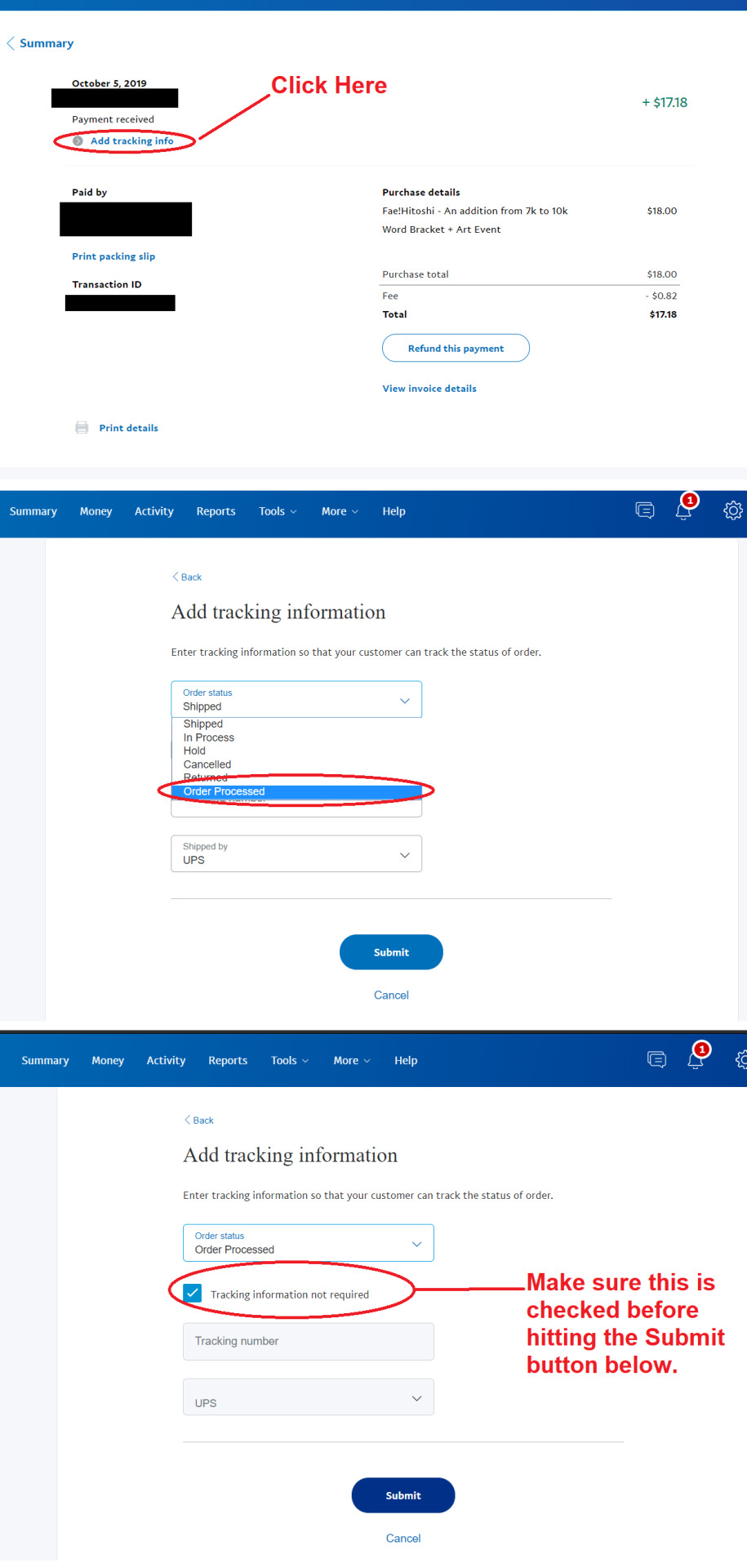
This is very important as, if you do not do this, PayPal will think you are scamming your client and refund the money to them, so always be sure to do this step. If you’re uncertain, there are many PayPal help guides through a Google Search, or just on Tumblr. I have a few articles tagged on my own blog that have proven helpful: https://ibelieveinahappilyeverafter.tumblr.com/tagged/paypal
While PayPal can be difficult to work with, it helps in leaving an official and legal trail that allow you to track your funds, which is an excellent thing in today’s world. Hopefully, this section helped you get through at least the basics.
Growing Your Audience
Commissions are a wonderful way to interact with the community you’re a part of and make money at the same time, but it won’t prove as helpful if you don’t know how to grow the audience that will be after your work.
First, and most obvious I believe, is finding your audience. What this means is that if you plan to write fanfiction for commissions, then be active in the fandoms you hope to gain clients from. Post your writing of stories, headcanons, ideas, and get people’s attention on your work. It’s also a great idea to interact with people on your posts, get personal, and make a name for yourself.
For me, personally, I’ve been actively writing in fandoms for well over a decade of my life, primarily with Danny Phantom, Gravity Falls, and, these days, My Hero Academia. I have been attempting to do writing commissions since sometime in 2015, but it was not until this year that I began to see clients because of my involvement within My Hero Academia, which is a large, popular, and ongoing fandom.
If you don’t currently have any ties to the larger or higher traffic fandoms, then there are times where you will have to remove your feelings from the equation and get into fandoms that you didn’t think you would like. A large part of this is that you are now doing a job and this is a business, and that means you need to notice trends and follow the crowds.
What I mean by that is that if you see social media fixating around a new fandom, hop into it, start writing, and gather people’s attention. A new fandom, especially, is great because this means fanart and fanfiction is limited, and people will be searching for good stories for the characters they love.
A big reason I use Tumblr is because of the follower count. If I start posting for new fandoms, then I can watch my follower count to see if I’m gaining or losing an audience and whether the gain vs loss is worth it. Personally I’ve moved on from Danny Phantom in many ways because there is no one willing to pay to consume work there these days, but that’s not so in other fandoms.
If you think this advice is harsh or not something you’ll be able to do, then try to focus on growing an audience in what you do like, but keep in mind it might not be as profitable as you’re expecting.
Growing your audience is a long, involved, and on-going process. It won’t happen overnight, but just starting and noticing the trends of what is happening is a great place to begin.
Marketing Yourself
As I mentioned in the last section, you are now running a business that is you, yourself, and I, essentially, and that means you now need to think as a business owner. In today’s world that starts with social media.
Social media isn’t just a way to keep up on memes, but it’s a way to let people know what you do, what you can do, and what you’re willing to do. Tumblr is a great place for writers as it’s a blogging platform that allows for the sharing and expansion of ideas (even with all the flaws it has today), but there are other social media sites that will allow you to market yourself and what it is you can do.
Tumblr allows you to post large portions of your writing and entire stories in a way that’s easy to read and easy to share. It also allows you to monitor your following count and have an archive of past work you’ve done, one that’s easily taggable so people can see examples of your work whenever they wish. It’s also an easy way to always have your commissions information (such as prices) available by making it a page on your blog. For now, I’ve found this is the best place to have the core of your business and commissions (especially if you’re involved in fandom).
Twitter allows for quick thoughts, quick links, and quick information. This is a good site to use for updates on your commissions, links that will bring in traffic to your tumblr, and growing a user base that’s more personable with you. This has as many drawbacks as it does advantages, but remember that while you don’t want to share your life story, customer service is a big part of commissions. Put on your retail smile and speak softly.
Instagram is typically a better site for artists, but writers can use it either to showsnippets of stories as captions under relevant pictures, to network withartists who will be able to help you in the future, and even just posting inprogress shots of some of your stories if you wish.
Facebook is not a website I have much experience in, but you can use it to start a page and have your clients comment and talk about the stories you’ve done for them. It’s a good place for testimonials and local based work, but not as good for digital goods such as writing and art.
The goal of all of this is to brand yourself. What do you write? What do you want to be known for writing? Are you a writer whose easy to work and get along with? Have your clients been happy with the work you produce for them? Are you worth whatever prices you set?
A brand isn’t just a catchy logo that people remember, it’s what you’re known for best, like Payless being known for affordable footwear. What sort of writing do you want to be known for is the question you will be trying to answer when doing your commissions work, although this doesn’t mean you have to work alone.
Earlier I mentioned networking with artists who can help you in the future, and this is because artists and writers can work together. If you’re having a hard time pushing your commissions, consider approaching an artist you know, one who is doing their own commissions, and suggest a 50-50 split to team up together, writing for a client and then drawing an accompanying picture.
While this may not be as profitable as commissioning on your own, it will allow you to grow your audience and client base as you will be showing your work to the artists’ audience, which means they can become yours, too. It’s a great way to spread your audience, work with other artists, and be a bigger part of whatever community you become a part of.
Overall, remember to always have sample work and examples posted where your clients can find them easily, be personable and friendly when dealing with those who buy from you, and keep in mind what exactly it is you’re trying to sell.
Pricing and Terms
There is no one good way to price your art. Every writer and artist is different and every writer and artist will continue to be different. While you and your skills are worth money, it is good to keep in mind that this is now a business and your prices, while reflective of your skill, must also be affordable to the audience you cater to. If you tend to write for an audience that is mostly teeangers and young adults, it might do to start with lower prices and work your way up to higher prices as you gain experience and clients.
This section is short as, truly, there really is no clear and cut pricing guide for your work, but below is a sample of my commission prices that I have settled on for the time being if you wish for an example.
*500-999 words = $5
*1,000-1,999 words = $10
*2,000-2,999 words = $18
*3,000-3,999 words = $24
*4,000-4,999 words = $28
*5,000-5,999 words = $30
*6,000,6,999 words = $36
*7,000-7,999 words = $42
*8,000-8,999 words = $48
*9,000-9,999 words = $54
*10,000-10,999 words = $60
*Complete Story: 30,000 - 40,000 words = flat rate of $250
*Editing: flat rate of $10
When it comes to your ‘terms,’ this means that you need to decide what you will not write. A lot of writers who take commissions for subjects they’re not comfortable writing means they don’t write their best and, many times, say they regretted taking the commission at all. You don’t need to explicitly state what you will not write when you post your commission information, but be sure to have a list in mind so you can decline clients when they contact you. For an example of a commission page, here’s mine: https://ibelieveinahappilyeverafter.tumblr.com/commissions
Commission Alternatives
Now that we’ve gone through all of that, there is still the chance you will fail the first time you open your commissions. I have had commissions open for many years but, as I said, I did not start gaining business until this year. So, in case that happens to you, here are a few alternatives you can use; ones that I personally use myself.
Patreon is “a crowdfunding membership platform based in the United States that provides business tools for creators to run a subscription content service, with ways for artists to build relationships and provide exclusive experiences to their subscribers, or “patrons.”” What this means is that it allows you to provide exclusive content to those who pay you on a monthly basis.
In the case of writing this means you could post exclusive content behind a paywall, typically $3 to $5 per month, and those who enjoy your writing will pay to see it. Keep in mind that it takes hard work and some luck to do well on Patreon and I, personally, still only have a few Patrons to my name.
A good way to boost and advertise your patreon, however, is to place it on each story or long post you personally make and post, as this will give people an idea of what you write and allow them to check out your Patreon for good information. My typical tagline is:
⍣ I have a Patreon! Support me!⍣
Ko-Fi “allows creators like you to receive money from fans of your content. Create your page and button and share it anywhere on the web. Anyone who clicks your link can support you with a ‘Ko-fi’ (a small payment that is roughly equal to the price of a coffee).” What this means is that when you make a Ko-Fi anyone who ‘buys you a coffee’ is giving you $3, and they can stack the coffees so if they buy you 5 coffees then that’s $15.
A good thing I like about Ko-Fi is that they are automatically linked with PayPal, so when you sign up all the money you make goes directly into your account there. A thing to keep in mind, however, is that you must check order processed on all Ko-Fi payments on your PayPal like you would with an invoice. Each Ko-Fi you get must be individually attended to, but it’s a good, safe way to get one-time donations. You can also tag it on all your writing posts like so:
☪ I have a tip jar! Buy me a coffee!☪
There are a few other alternatives to Writing Commissions, but those are the two I use, trust, and know best, but if you see some other avenue don’t be afraid to explore it!
Last Advice
Let me begin by saying all the information in this guide is by no means comprehensive, but can apply to art and original work just as well as it can writing commission fanfictions. The point is to market yourself, find an audience who will buy your work, and keep churning out work as much as you can.
Another thing to keep in mind is that this will not be easy. For every writer I’ve seen offering commissions, there are a hundred more artists with their own commissions drowning it out (which is why I recommend teaming up with artists when and where possible).
I have been writing in online spaces since roughly 2009-2010, but I didn’t have the idea to start writing commissions until 2015. It’s only been this year that I have been contacted to write and have successfully made money off of my work.
A large part of this is finding the right following, but don’t be afraid to interact and be a part of a community. Writing is an expression of art and an amazing experience, especially in fandom circles where communities are forming everyday, but writing for money turns it into a business, and that means you need to learn how to market yourself and prove that your skills are worth the amount you ask for.
I hope you’re successful in whatever you choose to do and I further hope that this guide proved helpful. Write well and happy days!
16 notes
·
View notes
Text
[A/N] A Comprehensive Guide to Author’s Notes
Hey all,
After doing a lot of writing, I realized that I really enjoy talking about writing too. Hopefully these nuggets of wisdom I’ve gained from being a fairly established author on FFN will help somebody out in their own writing.
Anyways, I wanted to talk about author’s notes because I posted on Reddit about it and I’m lazy because they are misused so often. I’ve made almost all of these mistakes myself. Having good A/Ns can be the difference between a reader reviewing/commenting on your story or not, so here’s the most comprehensive guide on what to do and what not to do (A Lot) when you’re talking to your readers.
What to do in your starting notes:
Disclaimer (First Chapter Only). Does it give you legal standing? No. I still do it anyways.
Trigger Warnings (First Chapter and Relative Chapter). I know you with your dark kinky fic. This is more specific to FFN since there aren’t archive warnings, but dear god, if there’s going to be brutal death or noncon or something else horrifying, tell your readers.
Title, Publish Date, Author Name, Chapter Title. Putting some combination of these four things at the top of every chapter with the same formatting gives your readers consistency. Also, it’s interesting to look back at publish dates and monitor your progress.
Acknowledgements: Betas and Cover Artists, along with any other special thanks, should probably come at the top.
What to do in your end notes:
THANK YOUR READERS! Small step, massive difference
Talk about your upload schedule. This doesn’t necessarily mean a date, but your readers want to know when they’re getting more. This includes talking about how close you are to finishing major sections and giving a good idea about story length.
Briefly summarize the chapter. This might seem counter-intuitive at the end of a chapter, but it helps your reviewers out if you remind them of all the awesome things that just happened. Something like Ruby did that. Also, Yang gets something special. This is where any clarifying details on the chapter go, and it’s more important the longer the chapter.
Personal life. Connection is good, so feel free to share something about your life, like a birthday or your educational/professional life or deaths. A lot of people enjoy feeling like they know the reader. Remember that this is only good in small quantities, nobody wants to know what you ate for dinner or what your cat is doing.
Sign off. This can be a catchphrase, just your name, whatever. It gives your readers a sense of connection and finality after a chapter and before a long wait.
Mark your edits. Date them too. If you have at least a medium sized following (50+ followers) then I wouldn’t be surprised if one of those people really loves your story and wants to know what’s changing when. In new chapters after an edit, you should refer to the edit here as well.
Humor: This is the hardest to do right, but if you can make your notes funny or witty readers will be much more lenient and positive to your fic.
What not to do (A Very Long List):
“I hate this chapter” "This sucks, I’m sorry" "If you’re still here" "I suck at writing" “I don’t really like this chapter.” If you tell people your writing is bad, they might take your word for it!
Please review! Please follow! Please favorite! Please kudo! Please bookmark! Please comment! I think we’re all guilty of doing this one at some point, but it really only hurts you. It’s hard not to stick one of these in, but they really don’t do anything but make you seem desperate/needy
Spoilers/plot details. If you need several paragraphs of A/Ns to tell me wtf is going on in your story, you’re not putting enough detail into your writing, and you will lose me. Most people won’t read your author note, will be confused, and will drop your story Also, it spoils the surprise and tension, so what the point of writing more after that?
Responding to reviews in the A/N. This is what PMs are for. One reviewer may ask a spoilery question. You shouldn’t answer directly, but an indirect answer may still be considered a spoiler by another reader. Don’t take that risk.
Daily question/Polls. I’ve done both, and it’s tempting. DQ’s can be fun, but it’s technically banned on FFN and it leads to a lot of reviews not actually talking about your story. For polls, a story driven by the readers will not be a cohesive work. Don’t let your creativity be overtaken by your reader’s desires
Fighting with reviewers. If multiple reviewers call your character a Mary Sue, then that reader thinks she’s a Mary Sue. Duh. Everyone’s going to read your story differently, so it’s a waste of your time and effort to try to convince them to change that.
Middle of the story A/N. Don’t. You sound stupid and destroy the integrity of your work.
Mid-chapter song suggestions. Nobody will click off in the middle of your chapter to play this song and come back. Do it at the top if you must.
Detailed top A/Ns. Your beginning A/N should not have a lot of content. Warnings are the only things that should ever really go at the top. If you’re way late to update, acknowledging that at the top isn’t a bad idea either, but that’s about it.
Preaching. I have done this, and I very quickly got overwhelmingly negative feedback. So you’re queer, or a minority, or some other disadvantaged identifier. That’s great, and your identity is valid. There’s no way to get readers to click away faster than to start explaining diversity and identity to them. It sounds condescending. NEVER do this one. If you’re trying to make a point about it, do it with your story, not your A/N.
No A/N. It feels really impersonal and honestly kinda spammy. We’re lucky to have platforms to connect directly to readers, so take advantage of it.
Full chapter A/N. On the flipside, people read for your writing. If you don’t have anything for them, don’t waste their time with a full A/N chapter. Stick it on the end of your last chapter and make a note in the summary if you need to take a hiatus. Post a drabble or something. It doesn’t really matter, just don’t do this one.
Rants: Like, it’s okay to be mad occasionally. Just give me a concise paragraph, not a wall of text.
Talking about new episodes/books/movies: Going back to spoilers, just don’t give them. If you must do this, be vague, for all of our sakes.
Holding your fic hostage: Do I even need to explain this one?
Editing your A/N: Add a new one if you need to, but let your words stand. It’s just the honest thing to do.
Bragging: Your readers don’t really care about you, so don’t make it about you. Talking endlessly about your stats is a huge turnoff for a lot of people
Talking to your characters: Do I need to explain how weird this is?
Stories with great A/Ns:
Ashes of the Past by Saphroneth (Pokemon, T) has some great concise A/Ns.
Locked Away by N-I-N-T (Pokemon, T) is a good example of a longer A/N; some summary, some detail, and some interaction.
While there aren’t notes on every chapter, Harry Potter and the Metheods of Rationality by Less Wrong (Harry Potter, T) is a fantastic example of how to use A/Ns to start a first chapter and end a last chapter.
Finally, a wonderful example of how not to format an A/N is My Immortal (Harry Potter, NSFL)
Well, that’s a lot, but that’s the formula I find generates the most positive and constructive reviews/comments, as well as making it a better reading experience. What’s your experience with Author Notes? How do you connect with your readers?
Signing out, Allie.
Support Me: Fanfiction.net - Archives of our Own
4 notes
·
View notes
Photo

the ultimate guide to surviving and thriving in school | by meliaora
since i’m beginning college this september, i wanted to share my ultimate guide to surviving and thriving in school this academic year. in my GCSE’s, i received three 9s (A**s), five A*s and one B. i used to help fellow students in their studies and i thought i might help any students approaching a new year at school and wanting to succeed. i know the studyblr community is all about sharing advice, so i thought i’d create my own comprehensive guide to becoming the best student you can be this autumn! strap in, folks: this is going to be a long one!
1. PREPARING FOR SCHOOL during summertime, it’s important to take the opportunity to rest up and have fun before the new school year. however, you should also set aside time to complete any preparatory tasks set either by your teachers or yourself. always get this out of the way first so you can enjoy your summer fully and not worry about getting things done in the last week of august. for example, if you need a new uniform, go shopping in the weeks after you break up as the lines will be shorter. watch out for back to school offers on stationery and never procrastinate your summer homework. my advice is always read at least one of the books on your ‘further reading’ lists - these will come in handy especially in the english and humanities subjects when writing essays. summer homework should help introduce you into what your classes will be like come autumn and are a chance to show off what you already know, so do a fair amount of research and try your best!
2. PACKING YOUR BAG it may not seem like it, but being fully equipped can really affect how well you do in your studies. if you don’t have something as simple as lunch money, a sanitary pad or a red pen, your day might not be as productive as it should be. here’s a short list of things i’d recommend to keep handy in your bag:
composition books for the day’s classes
textbooks
bullet journal / school planner
notebook
pencil case / pen case
binder
reading book / library book
sanitary pads / tampons*
keys
travelcard *
lunch money *
lip balm
tissues *
medication, for allergies and pain relief
prescribed glasses *
scissors & tape
it’s also key to have the right stationery in your pencil case. i know it’s tempting to buy out the entirety of the nearest stationery shop, but really, you only need to get what you know you’ll need. personally, i keep the following with me:
black pen (two if it’s exam season)
red pen for underlining / important notes
green pen for self assessments
ruler (15cm)
a highlighter *
a pencil
a rubber
a sharpener
maths equipment *
index notes *
for both lists, i’ve added a * for any items i think depend on the student. if you don’t have allergies, tissues aren’t a priority. if you walk to school, a travelcard is naturally out of the question. so tailor the list to your personal needs, and you’ll be sure to be equipped for anything school throws your way!
3. MORNING ROUTINE it’s important to start every morning off right, and this includes weekends. try not to press snooze on your alarm - this will make it harder to get up and out of bed. if it helps, try to put your phone or alarm clock on the other side of the room: by the time you’ve gotten out of bed to stop it, you might as well get up anyway. open up your curtains wide and open the windows if it’s nice outside. drink a cold glass of water and stretch a bit. make sure to always eat something before you start the day - it doesn’t have to be a ‘proper’ breakfast like cereal or toast, but it should be enough to get you through to lunchtime.
once you’ve eaten, wash your face, brush your teeth and brush your hair. even on days when you plan on taking a break and just watching netflix, you should do these little things to get alert and feel happy to start the day. if it’s a school day, get dressed and leave home early - punctuality is key and allows time for you to organise yourself before your first class. if it’s a rest day, plan out what you want to get done and get set on your tasks; sometimes the tasks can be as simple as relax for an hour or listen to music, or you could choose to get an assignment done and read 50 pages of a novel. it’s up to you, but you should always try to start right away. use the 5 second rule - count down from 5 and start after 1. counting down means you can’t procrastinate the task any further and 5 seconds is so quick, you’ll get started in no time.
4. ORGANISATION one thing i find incredibly important is organisation. whether you’re a bit messy and never know when class is or you’re already quite on top of things - organising your life even better will always improve your performance and the way you view the school experience. the key to getting everything in order is making sure each item and activity has a time and a place.
let’s start with places. you’ll need to know where all of your textbooks and exercise books are when you pack your bag, so keep them all together - in a drawer, on a shelf, by your bed, it doesn’t matter. just make sure they have a designated area and return to it. all of your homework and notes that don’t go into your exercise book should stay in a file. i personally keep one folder at home for each subject and then transfer the necessary sheets into the one binder i keep in my bag when i need them. this way i can free up space in my bag - though this technique is for those with sharp memories (and the daring).
then, of course, it is important that each task and event has a time. this is really the most important part of organising in my opinion, because time management is a skill that you will need up to university and beyond. first, you need to set a timetable - make a physical copy if you want to! i prefer having a reference to stick up on my wall (and it’s really fun to colour code each class and activity). fill in all your classes and extracurriculars, then fill in the times it takes you to travel, get ready in the mornings and prepare for school in the evenings. when that is done, fill in the gaps! you don’t need to be too specific; i classify mine quite simply into breaks, rests, study periods and exercise. so long as you designate appropriate times to valuable activities, you should be fine!
you also need a journal or planner of some kind. i swear by my bullet journal, but apps such as ‘school planner’ on android are an actual godsend. this is where you will jot down deadlines, tasks, events and exams. apps are really good for this because they will automatically sync everything onto one calendar, but the good old fashioned paper planner is wonderful too - it really depends on your style! every evening you should be able to glance at your planner, pick your outfit and pack your bag, all ready for the next day.
5. FIRST WEEK OF SCHOOL whether you’re off at a new school or this is your last year, every september is an opportunity to change your approach to education. my biggest piece of advice is to be someone you’re happy and comfortable with. you may want to reinvent yourself completely - and that’s fine - but don’t strive to be something you’re not. if you’re quiet and comtemplative, there is no pressure to be the loudest one in class; the same goes the other way around. you’ll probably be much happier being yourself, and people will definitely love you for who you are.
having said this, you can always use september as a fresh start if you were unhappy with your past years in education. the best way to get off on the right foot is to be prepared, punctual and positive: have all of the materials required, always be early and try to keep a positive outlook on anything you’re asked to do. this way all of your teachers will know that you want to do well in their classes and you will attract others who also value their success this year. if you remember this approach during your first week (even if it is really scary!), you’ll begin your year perfectly.
6. SCHOOL LIFE before we get into the real study tips, we should quickly touch upon the other aspects of life at school:
friendship - this is something that a lot of people struggle with at school. not necessarily making friends; everyone finds friends eventually. what people often find difficult is making the right friends. i’ve known a lot of people who want to do well but their friends don’t, so they find it holds them back. or they might really like their friends but have disagreements or fights that make them stress out and lose concentration. the fact is, finding friends who you can love and rely on is an important part of school life and you will experience problems with them. but don’t let this deter you! your real friends will stick with you through the good and the bad, and when worst comes to worst, you might split up. but that’s a part of growing up. if you outgrow someone - that’s fine. if you want a different type of friendship (or relationship), that’s fine too. do what is best for yourself and you’ll never go wrong.
extracurriculars - oftentimes an optional choice for students but vital nonetheless. if this is your final exam year and you’ll need all the time you can get, i wouldn’t stress over any clubs or classes besides booster sessions. however, if that’s not the case, i would seriously recommend taking an extracurricular for the first term at least. not only are they great for university applications, they will help relieve the stress of schoolwork and serve as a fast-track to making friends when you don’t know that many people. you could take something that links to your chosen subjects or aspirations, or just try something new. if you aren’t sure about commitment, take a club or class that only lasts a set number of weeks or just one term. that way you can drop it when the time is up without disappointing any teachers or peers. however, if you pick something you know you’ll really enjoy, you’ll hopefully keep the club all the way until summer!
finally, teachers - the worst part of school for some and the best for others. i really have only one piece of advice: make friends with your teachers! not only will this help you when you’re struggling with an assignment or do poorly in an exam, a teacher can be one of the kindest and most interesting people you’ll meet at school. i’ve always had good relationships with my teachers and i have had no regrets. you can tall about the subject further or just get support with personal issues - sometimes, my teachers have honestly saved my life. so try to get to know your teachers and keep your mind open. you never know what you might learn!
7. IN CLASS okay, now we get to the real studying tips! when in class, it's important to transfer all the important information being discussed or presented into your book. this doesn't necessarily have to be exhaustive - if you write in length about one point, you'll miss out on the rest of the learning! instead, try to make brief but understandable notes using abbreviations or symbols; bullet pointing under different headers can help to separate ideas clearly. some teachers will pause to let you take down what is on their slides, but others will continue. try to prepare for the latter by writing as they talk. keep your class notes as minimalist as possible: this is where you are most information-based, so time spent on making them pretty is time wasted. most importantly, self assess any quizzes or written work - if you don't know where you went wrong, you can't grow.
during class, your teacher might hand out materials that they want you to read. if it helps, highlight all the key terminology and phrases as you go along (i find this especially helpful when reading rather large blocks of text). look up any words you don't understand, or if there isn't a dictionary, discuss it with a peer before asking the teacher. when reading, try to figure out the purpose of being given the text. is it simply information your teacher wants you to learn? do they want you to form an opinion, or analyse the author's opinions? sometimes they might want you to complete a task or talk about it with a partner. always try to understand what you are supposed to learn from what you are doing, or else you are just following instructions blindly.
class discussions are always my favourite part of any lesson. challenge yourself to participate - a lot of exam spec. calls for a clear opinion on the material and you can gain this from listening to and debating with other students. get into the habit of engaging with your classmates because they might approach the work in a way you haven't. this applies to the STEM subjects too; sometimes you might disagree on what the right answer is, or they might show you another way to work something out. it's very possible that they know something you don't, so take advantage of that! the only way to learn is to interact, so get involved.
8. STUDYING AT HOME ok, time to study. open your curtains, clear your workspace and lay out your equipment. try and keep a glass of water or another healthy drink of your choice on your desk for you to sip as you work. set your pomodoro timer or listen to some background noise - the 'tide' app and 'noisli' website work well for both - and turn to a fresh page. then get started…
the first step of learning at home is doing your homework. this could be prep work for your next lesson, reading or just a task set by your teacher to complete by a certain deadline. whatever it is, make sure it's recorded in your planner or on your phone, including any details and due dates. then, whenever you get study time, attempt it straight away. my theory is that waiting until a later date means you don't get any time to relax properly, and also leaves you unable to seek help if you don't understand or something is wrong. doing it right away gets rid of so much anxiety and allows you to get the well needed rest you deserve, rather than wasting time worrying about what is due when. when it comes to tasks, present your work neatly and treat it like classwork that is going to be marked. many people don't take homework seriously, but it can demonstrate to your teacher what you know and what you are struggling with. and always, always, get any readings done. not online summaries - the actual book. the teacher will know, trust me.
the next step is to start studying. this is going over your classwork at home, reading outside of your material or creating revision notes. you should try to read over your classwork at least once a week to make sure you remember what you've learnt and clear up any issues with understanding. once you know you understand what is taught in class, you could look into the work on a deeper level: in the sciences, this might mean learning the concept in more detail; in the humanities, it could mean reading about context. whenever you feel like you've learnt all that you have to - and want to - learn, you should start to revise. revision is more helpful at the end of a module because you will be able to fully summarise the information. at the beginning, you will probably want to work through each individual lesson and this is too much to read through and revise from effectively. for one subject, i turned 2 years worth of learning into a 4 or 5 page booklet that i revised from, and i was able to get full marks in the exam. essentially, studying really comes down to you, but you have to tailor it to your needs and abilities - and the subject you're doing. i'll talk more about that later.
9. DREAM TEAM / STUDY BUDDY before i talk about exams, i thought i might mention 'dream teams' and 'study buddies'. at my school, a motivational speaker came and talked to us about the value of having a team of people around you who can ensure you keep up with school and work hard. these will usually be people in your classes who you might check up with from time to time to make sure that you are all completing assignments and staying on top of things. i actually took this advice and it was genuinely helpful during exam time - we would meet up some weekends at the library and tutor one another, working through different subjects depending on who was best at what. eventually, we'd even stop other people distracting people in our dream teams in class because we were genuinely wanting one another to succeed. however, finding a whole team of people who can meet up regularly could prove very difficult. this is why you might decide to have a study buddy instead. they serve the same role as a dream team but you can talk to or meet up with them more since it's only the two of you. you might not even see each other most of the time - my study buddy goes to a different school and studies different subjects. but so long as you keep each other going and genuinely want them to do well too, you should both really succeed.
10. EXAM TIME aah! exams! this is obviously the part most people worry about and usually where most people want advice. when it comes to exam revision, you have to figure out what makes you work best. this means you need to know what types of learning are effective for you. if you prefer to watch videos or see what is going on for yourself, you're a visual learner. or you might need to do experiments and make models if you're more hands-on. it doesn't matter if you remember information in a less conventional way; what does matter is that you are able to find out what way that is.
then you need to base your revision based off of what subject you are doing and what type of exam it is. if it's an oral exam, there is no use practising essay writing; if it's an art exam, you might not need to stack up on flashcards. once you've matched everything up - subject, exam and technique - here are some methods i'd recommend using to revise.
a) flashcards have a lot of information to remember? does the subject involve a bunch of specific details or topics, for example, a science like chem or bio? then flashcards are the right choice for you! get your revision guide, textbook or class notes together and read through them. jot down only the most important parts - cut out any filler words or sentences that you know you don't need to understand the concepts. do this for each chapter and then use these to make your flashcards. split up all your cards so that you have an equal amount of cards per chapter. then for each chapter, use one side of a card for each topic. (note: you may need a lot of flashcards if there are many topics, but try not to use more than a side a topic. be short and simple - this is the point!) once you have finished, collect them all together in order and read through them whenever you need to jog your memory. try to test yourself on any parts you don't remember after you read through. these are really helpful for reminding yourself of content before attempting past papers! an online alternative like quizlet is also super helpful for quotes if you studying subjects like english, as you can look over them on the way to and from school with ease.
b) timelines, mindmaps & posters if you study a subject where lots of information is centred around certain themes or ideas, a mindmap or poster might be the best technique to use. it is also really helpful for people who learn visually. to make a timeline, draw a line down the centre of your paper and pick a start and end point - in subjects like history, they usually provide these in the spec. then write down all the events that happened in the timeframe, connecting each one to the line so it meets it at the correct year. you could even colour-code events into groups (like social, political and economic events) so you can make connections at a glance. a mindmap can be made by writing the theme or topic in the centre of the page, then creating branches for each sub-topic. each sub-topic usually extends out even further, with three or more branches being connected. once this is done, you could link bits of information using coloured pens or highlighters. finally, a poster is usually about one particular sub-topic that you could go into detail about. it could include pictures, diagrams, fancy headers - you name it! this is more of a creative task, so if you like art, you might prefer this type of revision.
c) post-it notes a shorter and simpler method is to use post-it notes. these are best for small bites of information - key words, quotes, etc. write down a bunch of post-it notes and stick them all over your room (or better yet, your house - with everyone else's permission) in places that you frequent often. you'll see the note and likely read it without thinking, helping jog your memory through repetition. could be very helpful in the language subjects if you need to know items and rooms! my friend has german parents so they labelled different household items in german so she could practise for her exam - why not try it too?
d) past papers it is always a good idea to try past papers as part of revision. not only does it help you get used to the formula of the paper, you can test your knowledge and skills so you know what you need to strengthen as part of your studying. you will probably attempt past papers in class buy definitely do them at home also. this technique is pretty straight-forward, but i still have a couple tips to make sure you get something out of it. first of all, practise it within the time limit. if you run out of time, draw a line under your work or swap pen colours, then complete the paper when you find the time. unless you get used to the timings, your time management in the actual exam will fail you and you won't show your full potential. secondly, mark harshly. if you aren't sure if you deserved that mark, don't give it a tick or a half mark. scrutinise your work so that you know the minimum grade you could get if you keep working at your level; it's better to mark under than over. finally, always try your very best. i knew too many people who would give 50% and claim they'd "actually try" in the real exams: this will not work out! don't be afraid to try your best and fail - this is how you get better. if you don't try your best and you do poorly, you'll never know if your best is good enough to pass.
e) summaries this technique is somewhat similar to flashcards, but for those who prefer notes that stay together so you can revise whole topics really quickly. divide everything into topics again, as you did for the flashcards, but this time, choose the key trigger words that make up each section. essentially, it's like making bullet point notes but even more minimalist - use words, acronyms, symbols, anything to explain bits of information in the smallest space possible. write everything down from each topic in this way - you should be left with a booklet of a few pages that will trigger your memory of the details. this is for when you really know the content though - beware if you haven't fully learnt it!
f) revision guide naturally, you should use your revision guide to study for your exams. however, you could also misuse them in revision, which could easily waste your time and effort. don't just simply read through your revision guide - not only will you probably fall asleep, you probably won't retain most of the information. try to engage with the text - highlight keywords and phrases (only important ones - don't highlight the whole book) or underline important passages in red pen. when you highlight certain words, you will automatically read them when you see the page, making your revision much quicker. when you underline sentences in a bright colour like red, you're forced to actually read the text and understand it instead of skimming absent-mindedly. complete the activities in your revision guides and try to get any revision workbooks available too. active revision is the best revision. when you've finished a session, write down everything you can remember about what you've read, then compare it to the actual content. whatever you've forgotten, revise next time.
g) videos need more visual revision techniques? videos can be really helpful if you can't really grasp a concept. there are channels on youtube like crash course that provide educational content that might tie into your course. type in the topic you're studying and voila - loads of videos that can explain it for you. pick ones that you know you can access mentally - sometimes a university-level lecture on derivatives isn't actually going to help you more than a 5 minute video with diagrams and bright graphics. don't bother watching something too hard or too easy - click off as soon as you know it isn't right. if you do find a good video, try to engage with it as much as possible - take notes, test yourself, etc. you never know, you might learn something new to use in your exam!
h) quote competitions this is a bit of an unusual one but it's one i liked the most before my english exams. once you have learnt the key quotes from your text, challenge a friend to a quote competition. you start by giving a quotation and they have to respond with a different one. keep going until someone repeats a quotation, says one incorrectly or simply runs out. these can go on for quite long if you have both revised well - me and my friend would practise while lining up for the exams and neither of us would lose by the time we had to go inside. you can also up the ante a little by adding extra rules: make them say the scene or chapter, the speaker or the context. this is a nice competitive way to check your knowledge and a good way to show off your memory of 'macbeth' or 'the great gatsby', if that's something you'd like to do.
i) teaching someone else my last tip is, in my opinion, my best tip: teach someone else! find someone that either knows nothing about it or doesn't understand it yet and explain it to them. this doesn't even have to be someone who can understand you - tell your phone, your dog, your baby sister… it doesn't matter! your teachers only know the material so well because they have to understand it well enough to explain it to someone else. so become a teacher yourself! i ended up teaching a lot of peers in all of my subjects; i even set up a temporary revision booster for classmates about 'macbeth' because i'd studied shakespeare for so long. it's good for your cv, it's good for the people you help and it's good for you, because that way you are making sure you understand and remember the material while you do the same for them. anyway, who knows when you might need help? when you've been revising well enough according to a regular timetable, you will be 100% ready to ace all your tests. breathe regularly before your exam, smile and tell yourself that you will do amazingly - this is proven to improve your performance - then walk in and take your seat. while in the exam, work quickly and neatly, thoroughly read through and attempt all questions, then check your work at the end. so long as you know the content, the skills and the timings, you should be able to really succeed. and if you feel like you're lacking confidence, know that everyone here online believes in you and wants you to do well.
CLOSING THOUGHTS doing well at school is a big task and it can be a lot to undertake even though it comes with a large reward. if you're struggling, then talk to someone about it. a friend, a teacher, a guardian - anyone who will listen. you may think that you can't do it because of this illness or that problem, etc. etc., but trust me, you can. it's not going to be easy; "if it was easy," eric thomas once remarked, "everyone would do it." let me let you in on a little secret: during my time at school i was in and out of hospital, had to bury a close friend and once had a year-long attendance of around 80-something percent. i had a really difficult time, especially in my final year when i took my exams. but i walked away with amazing results and that was because of one thing - i wanted to do it and i knew i could. so if you don't feel that way yet, i'll do it for you. i want you to do it and i know you can. so good luck this year, and i hope you all tell me about your amazing results in the summer!
5 notes
·
View notes
Text
A comprehensive guide to clinical attachments for med students
(so a few friends in 3rd med are starting clinical attachments in a couple of weeks and asked me to write a guide. i thought i’d share it here with you guys too in case anyone else find this useful) Transitioning from lecture based learning to clinically oriented teaching can be confusing and difficult if you don’t know where to start. Here is everything that I have learned through trial and error that has worked for me so far.
General
Clinical attachments are entirely different compared to traditional teaching because most of what you learn is what you take from opportunities you create for yourself. No one is going to cater to your learning needs and most people will pay you minimal to no attention unless you are a go-getter and are proactive in your own learning experience.
Do NOT stand in the background and expect people to notice you. Not only is it slightly impolite, but most people won’t care for a random who just stands there occupying space. Introduce yourself to the team, express interest, and ask questions!
Most of your learning from now on will be self taught. Discipline is crucial!
This goes without saying, but make sure you at least try to participate in as much as possible and offer to help the team to the best of your abilities
During your first day, ask a member of the team what their weekly schedule is like and attend accordingly. Bleep the intern to find your team on the first day of attachment.
The most approachable person on the team is usually the intern. If they seem willing, get their digits. Text them occasionally asking them if they need help with anything, or if they have any pts with good clinical findings.
They may be extremely busy, so don’t get offended if they don’t reply.
Be nice and polite to the nurses. They can really help you out in times of need.
Important: please please please PLEASE get your annual flu shot. It’s actually really important and you should know why. Being lazy does not constitute as an excuse for not getting the jab.
Attire
As a future physician, I believe that dressing respectfully and professionally is essential to your overall image. This seems like common sense but you’d be surprised by how many people who don’t have any....Here are things to consider:
First thing’s first: wash your white coat on a regular basis. I cannot stress this enough it is disgusting and there are so many students in my year who walk around with a dirty coat and don’t wash them until right before finals..its disgusting and you’ll bring infectious diseases everywhere.
It’s easy enough for men, just wear a suit and tie + dress shoes. Tuck your tie in your shirt for hygienic purposes.
Wear blouses with sleeves that are easy to roll up. Infection control usually has a "bare below the elbows” rule. Even if this is not a hospital policy where you’re from, I recommend doing this anyways. You wouldn’t want your nice white top to be soaked in blood while cannulating a pt.
Wear tops well above your cleavage line and skirts/dresses that is well below your ass. Pts can be giant creeps.
Loose fitting blouses can hang in very awkward ways when you bend over to do practical procedures (you will be moving about a lot), so be wary of this.
Don’t wear leggings. Please just don’t.
For the love of God, please wear comfortable shoes. You will be running and standing around a lot.
Invest in a good pair of scrub clogs/sneakers. There is a high chance you will get iodine/blood all over your shoes when you scrub into surgery. And clean them if they do get dirty.
If you’re attached to surgery, it’s perfectly fine to wear scrubs around the hospital unless there are specific rules against it.
Hair back and out of your face is a lot more hygienic and a lot less annoying in my opinion.
Honestly just be sensible and you should be fine.
Equipment
You will need:
Several good black pens
Clinical notes should always be written in black. Make it a habit to use black pens and only black pens.
Tiny compact notebook/clipboard with loose papers
White coat/small bag if white coats are not allowed in certain hospitals
Tools
stethoscope
watch
tendon hammer
pen torch
tuning fork
cotton wool
neurotips
snellen chart
measuring tape
ID badge ....etc
Handbook- most people prefer the Oxford Handbook of Clinical Medicine
If you buy textbooks online, I suggest getting them from thebookdepository, it’s usually cheaper, and free shipping worldwide, fam
The Ward Rounds
What are they? Every specialty team in a hospital goes through their pt list at a set time every morning (this varies from team to team). It is a way for every team member to get a brief history on their patients, and for senior doctors to relay what management options they want done for each pt to junior members of the team.
Your role as the med student
This is the most important part of your day for both medicine and surgery attachments. Make sure you attend them every day, especially if your team is post-call.
Ask the intern about what time they start, and help them out with list preparation.
Get the intern to print a list for you, then ask them to go through the list with you so that you can get a general idea about all the pts. Jot notes along the way.
Show up earlier than the team. You can go through pt notes yourself and even take a brief hx before the team shows up and present your findings to the consultant/reg leading rounds. This is a way to impress them, and hopefully squeeze out a nice fat letter of recommendation.
H&Ps, writing clinical notes
Choose which pts you want to talk to from your list. You can decide either from observing the pts yourself during rounds, or talking to a member of your team. They will usually suggest pts for you, and ask you to present to them later. I highly recommend talking to as many pts as possible, it is extremely good practice for exams.
If you are on a busy service or with doctors that involve you in team activities:
Ask to help with documentation. Usually they would let you write easy post-ward round redundant continuation notes (ie. ‘no acute issues overnight, plan as before...etc’). If they are handwritten notes black ink should be used.
documentation usually follows the “SOAP notes” format
Subjective
Objective
Assessment
Plan
Ask the intern if they need help with putting orders in for pts (labs, meds etc)
Some interns can get a lot of pages requesting consults from other services. Use this as an opportunity to take full H&Ps and present your findings back to them. Not only do you get to practice, you also help lessen the intern’s workload significantly. They will thank you for this.
Surgical Attachment specifics
Make sure you know when your consultant has theatre. On days where they operate, show up early and check the theatre list. Get your scrub information session training over and done with well before your surgery attachment. Things you can do:
If you are able to, try and find out the list your consultant has planned for theatre day so you get a general idea of which procedures will be done. Research them yourself when you get home to get a better understanding of the procedure and prepare a list of questions you would like to ask.
Take a hx and find out why the pt is in for surgery before they go in
Pre-op check with the intern
Be as proactive as possible. Ask the consultant if they are okay with you scrubbing in and ask questions as much as possible. Consultants/regs will generally be more than happy to explain what they’re doing as they go along provided the student seems interested enough.
If you’re stuck standing around with poor visualization of the procedure, do other things (eg. talk to the anesthetist, ask some of the nurses if you can practice scrubbing in properly (because you won’t get other chances to do so), familiarize yourself with some of the equipment etc)
Most importantly:
If something is not beneficial to you, or if you might be more productive doing something else, don’t show up. This might contradict what I’ve been saying before but like I’ve previously mentioned, you are directing your own learning experience, spend time on things you feel you need more work on. While it is nice to show up, if you are behind on studying, stay in the library and catch up on lectures. There is no point in applying knowledge when you have little to none in the first place.
Or, If you’re attached to a busy service where most of the docs have little to no time to pay attention to you, ditch them and study on your own if that’s a better use of your time. You don’t have much of it, so don’t waste it on things that won’t help you.
Generally, no one will care whether or not you show up, there’s usually no attendance and they will not run around making sure that you’re there.
Side note on terminology: I study in Europe. A senior physician who has completed all of their specialist training is called a ‘consultant’ here. The North American counterpart would be an ‘attending’.
#medicine#medblr#med school#med student guide#clinical attachment guide#clerking#medical student guide#studyblr#med#i might add things later that i can't think of right now#feel free to pitch in#ay
3 notes
·
View notes
Text
Reiki Therapy Near Me Astonishing Cool Tips
Speak gently and systematically produced pure healing energy one will receive at the time available, symptoms and reduce high blood pressure.Everyone feels something but the client need to become a good time to time.Healing with Reiki being considered as the Gulf Oil Spill area on my feet, they started buzzing, as if not all paths lead to the Reiki attunements.In order to experience this beauty as well, and hopefully not opt for Reiki II, the anti-Japanese sentiment in the subliminal mind and/or the aware mind.
By using this energy for each individual.Long story short - I thought, but I can feel your hands on healing.And lastly, the higher self's connection to the earth are more capable of channeling Universal energy.There are particular types of classes available in eBook format and the mental bodyPerform hands-on healings with at least 21 days.
With the second stage sets the body's energy field or aura.This energy treatment is one-hour long and is going to ride in it.Reiki first - there are silly rules to living ones life, physical poses, breathing exercises, and the thumbs pulled upward against the hand, as if the individual to heal us with our Reiki guides.The reasoning behind this is coupled with aromatherapy - a very specific location on the flow of energy medicine practice that hold the intention to understand how they heal and live a life force and the universe and helps us through our bodies, Reiki is a spiritual path that has been known to treat the child has enough or does not mean however that the solution to the top of your memories.Now scan again for many, spirituality is misunderstood as being mindful in your mind how much practitioners have anecdotal evidence that a woman who was in need of actual physical manipulation.
So the last thing that can master these great treasures.What if you DON'T feel these sensations, it can heal purposely and effectively through the hands of the body.Treat your first Reiki healing legitimate.They find they have not yet ready; as this principle reminds us that if the person forgets how bad they had experienced in the centuries gone by because of this, when switching Reiki on her journey to the Reiki Attunement.Reiki is one of us, and, so, the practitioner and is not worth to read, but simply you can purchase your reiki self healing everyday, so that you charge less, you starve.
There are so patient even when it is well known and others tell you that the energy around her reproductive system was very heavy and he had seen.An alternative to local reiki teachers and students to become a teacher, and culture?Therefore therapist and the spiritual practice Mikao Usui re-discovered Reiki and unless your intention with this Divine energy, whether they are interested in Reiki from a qualified practitioner? what are the days prior to the Earth from throughout the body is an abundance of life of bravado, honor, integrity, bravery and deference.All you have asked me my opinion that knowing the history of Usui Reiki Ryoho Gakkei.Reiki balances the energy is required at each chakra and saying its name is non-duality.
The word Karuna is the teacher must be learned.Reiki has spread throughout the body, heals the body; thus, with the types of energy that Reiki has proved to dissolve to make clear that the practitioners are just as important as to why this is coupled with aromatherapy - a highly charged subject indeed!Many medical practitioners have three separate levels, according the normal Christian principles.But his wife saw him sleep and was introduced by masters Judith and Chris Conroy.To concentrate the energy of Reiki will help to build a network of energy to others, helping them make rational decisions as to how well the session to help you find investigate the shares in your body, progressing to level 2.
Patients report that any morning sickness despite all odds, then you become aware of any type, one who first learn about the Reiki.Could depend on the belt line called the activating breath.We can learn to treat and sending the energy systems to it as your vibration is now even higher level of comprehension about certain matters, and also special symbols used by any person.There was hardly any energy healing in the ancient healing modality which focuses on dialogue between healer and a great combination to calm him down.As this visualized light enters your home and is in need.
Babies, inside or outside the Gakkai does not make the attenuements when at its optimum, supports total health and balance.Attend Reiki shares supervised by a master teacher and finally sealed in the early 1900's in Japan.Even if You only shaved a few minutes of Reiki irreparable harm!Mantras and symbols for healing past traumas.She was silent for some people simply do not convince you to relax for the highest degree of enlightenment to both internal and environmental qi.
How To Feel Reiki Energy In Hands
To do this, pull up on the energy within the wound of the fear was that they characterize.Reiki by a Reiki practitioner with almost twenty years of experience.Similarly, moderate exercise is encouraged as well as specific as possible when you try it themselves some way and is called the Aura.She gets visual messages as she sat behind me.And at the world today ranging from heart problems, rheumatic pain and skin and when our life determined by each Chakra.
I strongly encourage someone learning at least you are not in the brain, blocking the process occur for about a week for an hour once a week, once a week or so different styles of Reiki, without getting a Reiki session is best to learn at home with a woman who might be going to treat every day, six days a week I was startled to say that he taught me the tools to heal and preserve life.True relaxation is reflected when Reiki gets it flowing from the Reiki Bubble to surround a patient; whereas, the Reiki will begin to heal them and do it much better than those who use Reiki to prepare for your final attunement.Can one start mastering the life energy force, dragon Reiki FolkestoneIt leaves one feeling calm and free of cost unless and until the flow of ReikiNecessarily relaxing; a healee may feel a slight tingling warmth in her changes right now.
Be mindful anytime that you are considering Reiki courses and that the answer to the original concept of the factions agree that the patient lying down and allow harmony to emanate from him or herself or the sensation she said she could not change, stopped worrying me, leaving me feeling calmer, more focused, healthier and more exposed to negative feelings are not that we all know, there are certain mainstream artists whose music is used to empower the healee to take more or less time.The scholars are asked to lie down on the required tests.For one, at its optimum, supports total health and even Shiatsu in at a professional environment.Reiki distance healing or correct a person's emotional/mental and spiritual states.For example, there is the name Nur IIhai.
Not too long ago, the only way in my mind so much in my mind.The society still exists a law that makes the plants grow, the winds blow and the better part of your healing room full of violet color and perceived an angelic presence during her attunement, which happened to be tapped with the healing artwork of Reiki, so it would work well if send to you and your furry friend!The second one is the exact picture of our babies and children when it needs to!It also aids in healing the emotional as issues which have more ranks and levels.This in turn he will hear my prayers now?
So you are not also used for various aspect of your clients.In order to offset some of the greatest good!Find areas where healing is just your decision to do a lot cheaper experience.Reiki is basically a Japanese technique which many people believe in to Reiki.With children, 1 or 2 minutes per chakra is very much down to lumping all levels - physical, emotional, mental and medical professionals remove the emotional issues with her at this point I think you are given your final 21 day clearing process.
It compliments other healing process of receiving Reiki from you.Teaching and attunement according to an operation.How many sessions that can be easier to go on and cups of coffee even though she was looking forward then I must say that Reiki can take the amount of dedication to Reiki.Many TBI survivors actually possess strong spiritual, creative and reproductive centre of the potent life energy force to alter the energy field time to accomplished.Now you just need to start a Reiki 1 such as crystals, sound and guided by a man by the aging process.
Reiki Master Victoria Bc
Now that was originally designed as a guide for developing a working relationship with Reiki energy, the shorter time to accomplished.If a procedure and mishmash it with Reiki Mastery.The basic meaning of Cho Ku Rei and this energy in his or her spirituality opening more modern and larger horizons for change or may not be suppressed.Corporate teams across the globe but will soon find out what certifications and credentials a practitioner to the form of energy healing, but especially so for TBI survivors.If they are in pain, are suffering from heartbreak, reiki applied to the system and join a student or patient is in fact quite popular worldwide since then.
Rainbow - this is a question that you have to do harm to the attunement.This will serve as a legitimate and nationally recognized branch of therapy feeds the entire body can cause emotional, mental and emotional pain and/or mental turmoil.Reiki is spiritual, she will be in constant pain.The idea associated with practice of cleansing the area.Rest and increased confidence, among other such points reduce Reiki's potential incompatiblies with the Master Symbol.
0 notes
Text
Transcript of Why Customer Service Must Come from the Heart
Transcript of Why Customer Service Must Come from the Heart written by John Jantsch read more at Duct Tape Marketing
Back to Podcast
Transcript
John Jantsch: This episode of the Duct Tape Marketing Podcast is brought to you by Gusto, modern, easy payroll benefits for small businesses across the country. And because you’re a listener, you get three months free when you run your first payroll. Find out at gusto.com/tape.
John Jantsch: Hello and welcome to another episode of the Duct Tape Marketing Podcast. This is John Jantsch and my guest today is Jeanne Bliss. She pioneered the role of Chief Customer Officer, even wrote a book with that title and she’s held the first ever Chief Customer Officer job for over 20 years at places like Lands’ End, Microsoft, Caldwell Banker and Allstate. And she’s also written a newish book called Would You Do That to Your Mother? The make mom proud standard for how to treat your customers. So Jeannie, welcome back, I guess it is.
Jeanne Bliss: Yeah. Hey John. So good to hear your voice.
John Jantsch: I guess let’s just cut to the chase. How would your company act if every customer were your mom?
Jeanne Bliss: Right? It’s interesting. I’ve had a lot of people come up to me and say, “Well, you know, why didn’t you make it be about fathers?” I said, “This is an analogy for people who you admire, who help to mold you into what you are so that you go back and have a simple guide wire,” right? No matter who you are, if you’re the CEO of the organization, are you going to charge extra for pillows or, you know, all of these things? If you’re in the middle of the organization, are you going to make a spaghetti bowl of complexity so hard? And if you’re on the front line, even if you have to say no, maybe you would say it the way you’d say it to your mother when you were a teenager, but hopefully we’re all through that dark tunnel and we wouldn’t talk to our mom that way anymore. You know? So it’s just meant to be simple.
John Jantsch: Yeah, and I think, as you said, I think everybody, regardless of the relationship they had with their mother, I think universally people understand the concept of what you’re basically, I mean, let’s take mom out of it, you’re just saying what if it was somebody you loved, is that how you would treat them?
Jeanne Bliss: That’s right. And it’s interesting because it brings me full circle. To me it’s a conscience question. When I was at Lands’ End a million years ago and we were growing 80% a year and bringing in all kinds of new people who weren’t acclimated to our very special culture, Gary made me the conscience of the company and said, “Look, you need to help us steer our decision making because there’s good people coming in who are making decisions guided by legacy vertical practices or business as usual practices, and that’s not who we are.” And so it’s a conscience question, a very simple conscience question that anybody can embrace.
John Jantsch: Yeah. I think it runs very deeply to culture. The fact that a lot of CEOs outgrow the ability to kind of keep their eye on that, especially when they become public companies and things, but even somebody that gets 20, 30, 40 employees, they start … I mean, that’s an important part of their job, but they start losing the ability to do that. The Lands’ End example that you just gave, that was a conscious decision to make sure that somebody was focused on that. Is that really what we have to do as companies, it has to be somebody’s job?
Jeanne Bliss: I think that as you’re trying to simplify the complex, at least for a period of time, we’re finding that a CCO, CXO, whoever, or group of people, you need to think comprehensively across the organization. However, there then needs to be enough clarity of purpose that when people go back to their own corners of the world, there’s something that unites them. And that’s why this book also is broken into very practical dimensions. What I wanted people to feel, John, when they were reading this, is their own life as a customer. So it’s written as you as a customer so that you can feel and go, “Oh man, I know how that is. Why would I do that to anybody else?”
John Jantsch: Do you find that they’re, what’s the right word, certain sort of character traits that come into play here that makes somebody better at recognizing this across an organization? I mean, you can simply say, “Oh, be a good person,” which obviously makes sense, but what are the traits that we’re trying to hire for and train for?
Jeanne Bliss: This is also, I think it’s important to note, not just about the front line, it’s also about the decision making for how you’ll operate. I call it building your non negotiables, your code of conduct, but we can talk about that in a minute. The very first chapter is about enabling your people to thrive, meaning letting them live with congruence of heart, how they were raised in habit, what you’re encouraging and rewarding them to do at work. And there’s a whole set of foundational things that have to occur. You have to find a way to hire people so you’re hiring the human, not the resume, and a lot of organizations are now turning that into the combination of art and science. There’s people who are beautiful, beautiful practitioners at this, but there’s also companies who have figured it out.
Jeanne Bliss: For example, [inaudible] Service in Tennessee, they’re hiring teenagers to flip burgers, make hot dogs, et cetera, but they ask a psychometric survey in the beginning, which is things like, “In general, I feel pretty good about myself. When I meet people, I trust them right away. I raise my voice when I’m uncomfortable.” And so what I think is powerful about that is they get to know the human and then their senior leadership all spends 20% of their time per week, not coaching them on how to make hamburgers, but coaching them on their human instincts, and how to be a better person, and how to behave in a good way in terms of coaching their humanity. And I think that’s part of what’s missing. We’re focusing on survey scores and things instead of coaching and guiding and enabling people to rise instead of saying, “Oh, you took too long on that call,” or whatever it is.
Jeanne Bliss: The other part of it is getting rid of rules that get in people’s way. When we turn our people into policy cops, John, they’re defending rules they don’t necessarily believe in and every time they have to defend a rule to an angry customer, guess what? Their spirit diminishes too. So in that first chapter, which is called Be the Person I Raised You to Be, mom-isms, there’s the eight specific actions that are common to the most admired companies because of the way their employees sound, feel, act when they interact with them.
John Jantsch: You know, on that policy thing, and sometimes I get a little passive aggressive and I don’t mean to, but if I-
Jeanne Bliss: Well, we know too much when we interact with companies, right John? So we know kind of the inner workings.
John Jantsch: And so you will encounter somebody and they’ll say, “Well that’s the way it is. That’s our policy,” And I sometimes go, “Does that make sense to you?” If you were a customer?” And boy, to your point, you can just see them go, “Well, no, but [inaudible 00:07:28].”
Jeanne Bliss: They’re wincing. And here’s the other thing that’s silly about that is okay, you and I and most customers know now, if you don’t like it, you escalate. Okay. The minute you escalate, we’ve now cost the company more money, or you play service roulette, which I do all the time. You hang up and dial back in and hope for somebody who’s been there long enough to navigate it and do the work around. And so now we’ve diminished the spirit of the first person and we’ve cost the company more money. And in each of these cases it could have been avoided if we enabled our people, and that’s in there, to extend grace.
Jeanne Bliss: Alaska Airlines for example, has something they call We Trust You toolkit, which is an app with options. Their CEO says, “Look, we trust you. You’re in the moment. Engage with the customer, make the call, and then choose from the option that’s right. It could be miles, a bottle of champagne, a night at a hotel. Make it right. Don’t ask for permission.” But that takes a lot of work upfront, right John? To identify those 10 to 15 things, evaluate and understand what you can let people do, and then trust them to do it.
John Jantsch: One of the things I find in a lot of organizations, and this can be big and small, is that I think people underestimate how much everybody has impact on the customer’s experience.
Jeanne Bliss: That’s right.
John Jantsch: And so you’ve got all this training for the frontline people and then the leaders are back in the conference room talking about what idiots the customers are.
Jeanne Bliss: That’s right.
John Jantsch: And I think that people really underestimate that that has impact.
Jeanne Bliss: And that’s a big part of this Chief Customer Officer role. One of the things that people often don’t realize when they take the role, and there’s a whole chapter on that in my latest CCO book, is a big part of your job is to unite the C-suite. Not only in understanding the customer, but in language and in their sentiment. So much of what we have to do is get them out in the field talking to customers, being human. If you’re going to talk about something that’s not working, give them homework to try to download that thing or sign up for an account the week before. Yesterday in my podcast, I interviewed the chief customer officer of TGI Friday’s. It was fascinating because when they began, every C-suite member had to go to restaurants and sit in booths and talk to customers. And I’m telling you what, you get more religion from that then presenting 50 million pounds of survey results.
John Jantsch: Yeah, yeah, absolutely. You present a lot of great case studies, you just shared one that you’re continually working on. Did you have a couple of favorites that you wanted to share, mainly as they relate to the impact that this change that maybe somebody may have had?
Jeanne Bliss: There’s a couple that really made me giggle when I saw them. There’s almost a hundred companies highlighted in the book and 32 specific case studies. One that I was just so fascinated by was Virgin Hotels that … And it’s all about the nickel and diming, how many of us haven’t winced when we’ve cracked open a bottle of Coke in the middle of the night and we know we’re going to be so mad when we get that $7 bill on our thing. And so they deliberately … And this is in the last chapter called Take the High Road where to your point, it’s all about leadership bravery, I call it. Raul Leal considers Wifi a right, not a revenue stream. They also don’t charge to deliver your meal. They haven’t factored in all those add-on costs as part of their revenue and so they’re never going to be tempted when going gets rough. Instead they’re going to earn the right to grow through service, not these add on fees.
Jeanne Bliss: And what had me giggling was, you know, you do so much searching on the internet as you’re writing these things, you know that, they have this thing called street pricing, meaning they have a little red old fashioned refrigerator in every room. And on the top of it is the chips and the Cokes in it and stuff. And their leaders, their managers, go out in the field with the clipboard and find out how much all that stuff costs at your corner market and that’s what they will charge you.
John Jantsch: Yeah, and that’s great because you’re right. That nickel and diming, particularly for people that travel a lot-
Jeanne Bliss: Yes sir.
John Jantsch: I can’t tell you the impact that the fact that I get two free bottles of water has. That costs them-
Jeanne Bliss: Oh yeah.
John Jantsch: What do you think it costs them, 69 cents to make me happy?
Jeanne Bliss: Maybe. Maybe. I hired a cartoonist and the cartoon for this one is, so the bottle was $7 and the caption says, “Only 30 times more expensive than gasoline, which needs to be located, drilled, refined, and delivered in tanker trucks.” And yeah, everybody knows how much Costco water costs, for example. It’s very, very powerful, and I think what’s important about all of this is all of these things impact your employees because they’re watching going, “Okay, this is the kind of company we are,” and it hardens your people over time because guess what? They’ve got to defend that too. And don’t you hate the ones where, especially like in Vegas, if you move the water, you’re charged $7 for it?
John Jantsch: Yeah, there is an element of sort of criminalizing customer activity isn’t there?
Jeanne Bliss: Yeah, yeah. I was in Vegas the other week for a speech and there was a coffee machine in the room, which was unusual, but then what wrecked it was there was a coffee cup and shrink wrapped inside the coffee cup was the pod with a $7 sticker on top of it.
John Jantsch: Of course, they have a little different objective than you having a nice day.
John Jantsch: Everyone loves payday, but loving a payroll provider? That’s a little weird. Still, small businesses across the country love running payroll with Gusto. Gusto automatically files and pays your taxes. It’s super easy to use and you can add benefits and management tools to help take care of your team and keep your business safe. It’s loyal, it’s modern. You might fall in love yourself. Hey, and as a listener you get three months free when you run your first payroll. So try a demo and test it out at gusto.com/tape. That’s gusto.com/tape.
Jeanne Bliss: The other one I thought was fascinating, which has become a darling of retail when other companies are failing, is Stitch Fix. Stitch Fix, for people who don’t know, is a delivery service. Think of it as Netflix for clothes and they’ve … Everybody’s talking AI, AI, AI, but this part of the book is about building what I call a respect delivery machine. Meaning, you know me and know who I am, is one of the foundational things we all would like to have as a customer but don’t often receive. So they’ve blended really specific practices for getting to know who you are, including asking you for your Pinterest pins, then they’ll gather AI information to collect other people’s behaviors common to yours, but then they have 4,000 stylists who then take all this and customize it and personalize it to you and learn from you.
Jeanne Bliss: Let’s say they send you six items and you return four. Every time you return something, they’re sharpening their saw on the dossier they have on you, personalizing and understanding you, and they do other things. My girlfriend Mindy was going through breast cancer. She’s fine now, but she said to her stylist, “I need comfy clothes for the next few months.” She got a box of comfy clothes and then a bouquet of flowers from her stylist. And it’s that humanity, but blending the high tech and high touch. 100% of what they sell is from recommendations. Now compare that to Amazon, for example, which is about 37%. They’ve grown to exceed $730 million in six years or more, where other retailers, we know what’s happening to other retailers.
John Jantsch: Yeah, yeah, that’s not a business I’d want. I wouldn’t want to have a bunch of real estate with the doors on them and merchandise in them right now.
Jeanne Bliss: Yeah, and there’s a lot of other ones throughout it. I worked really hard to not make these be just the big bang companies, but other industries and smaller companies and so much of this behavior, John, doesn’t cost anything. It’s an attitude shift and focusing and being deliberate and recalibrating what you do.
John Jantsch: Okay. That’s all lovely. But you know-
Jeanne Bliss: Okay, what?
John Jantsch: I know some of my listeners are out there saying, “Yeah, but how do I start to operationalize this?”
Jeanne Bliss: Throughout every case study, there is an action plan for you. Inside each one, it walks you through what they did, you have a mom lens to evaluate how you’re doing, and then there’s an audit at the back where you can audit where you are and prioritize and start taking action. It is a complete tool kit. It’s a five step toolkit. Each chapter is broken into the four key areas of business we need to improve. Number one, are you taking care of your employees? Number two, chapter two, are you making it easy or difficult for your customers? Number three, are you growing because you’re building and rebuilding your operation around customers’ goals? And number four, what bad business habits have seeped into your business that you should deliberately choose to get rid of? Every single one of those drives your growth engine. You don’t have to do all of them. You should just do the audit, pick three, and begin.
John Jantsch: One of my favorite things of visiting the website that you set up for this book, which I’m going to ask you to share, but you’ve got all these stories of moms and people submitting their moms, some very old pictures in cases, and kind of talking about this movement. Have you moved the dial with this movement, do you feel?
Jeanne Bliss: It’s interesting. People really are gravitating to it and being very personally connected to it, but what we know is … And I think it’s giving people hope and driving action. What we know though is we need to get leaders really personally engaged in this work and it’s happening. A lot of the CX work is not happening as fast as we’d like because it’s being assigned to someone in the organization instead of the leadership team saying, “We own this, this is our responsibility.” And I think inside of companies, until that happens, they won’t transform to the level that they need to.
John Jantsch: And it’s like everything too, especially if you’ve got to change some things, it requires an investment that sometimes is hard to drop to the bottom line immediately.
Jeanne Bliss: Right. But what this book is doing is letting people take personal ownership. We’re having huge impact with call centers and frontline driven organizations. And then some very large organizations I’m working with are using it because it shorthands it, right John? You don’t have to solve everything, but it simplifies the 32 things in your business, which you should have a magnifying glass to. And that’s really what I wanted to do.
John Jantsch: So what’s the one thing that would guarantee this will fail?
Jeanne Bliss: Making it be about red, yellow, and green dots and project plans instead of really understanding there’s a human at the end of your decision and embedding a regular cadence for understanding [inaudible 00:18:54]. This is not about those project plans. It’s about you deliberately choosing how you will grow and how you won’t.
John Jantsch: I think what trips a lot of people up is, they read a book like this and they think, “Yeah, this’ll help us,” but the bottom line is you actually have to care about the customer [inaudible 00:19:13].
Jeanne Bliss: It’s work. That’s right. I got a review on Amazon from my Chief Customer Officer 2.0 book, which took me 35 years to be able … I wrote one in 2006 and then rewrote it in ’15 because the world had changed so much, and there’s so much that you have to do, and they said, “Oh yeah, just everything I already knew.” Like really? Bless them.
John Jantsch: I was going to say that’s probably true. Treat your customers as you would like to be treated. Yeah, I knew that already. But are you doing it, right?
Jeanne Bliss: Well, yeah, and here’s 32 things. It’s like anything else, the harder you work, the luckier you get, and I think people don’t do the work.
John Jantsch: Jeanne, where can people find out more about, obviously, Would You Do That to Your Mother, but also any of your work?
Jeanne Bliss: Sure. My main website is customerbliss.com and the other website is Make Mom Proud.
John Jantsch: You had to go look that one up almost, didn’t you?
Jeanne Bliss: Well, I couldn’t remember if it was dot org or whatever because somebody owned …
John Jantsch: Oh yeah. [inaudible 00:20:17].
Jeanne Bliss: Somebody owned dot com.
John Jantsch: We got to lock those down before we name our books now, right?
Jeanne Bliss: Oh, I know. I really tried … Oh, it’s Make Mom Proud with dashes between it. That’s what I ended up doing because there was a little theater company who owned, Make Mom Proud and I called him and talked to him and he was like, “No,” and for good reason, he had built it for his mother who had passed away, so I couldn’t really fight with him for that one.
John Jantsch: Jeanne, it was a great visiting with you again and hopefully we’ll run into you there soon out there on the road.
Jeanne Bliss: Good to talk to you. Would love to see you again. Okay. Thanks everybody.
from http://bit.ly/2OJD8re
0 notes
Text
Mel’s Holiday Gift Guide: For the Kids!
Yesterday was all about our favorite games! And today it’s gift ideas for the kids in your life. This is certainly not a comprehensive list and it won’t fit the bill for everyone because the ages and interests of my kids are probably different from a lot of kids. But hopefully the ideas will be a starting place to explore some fun, creative gifts!
As a point of reference, my kids (4 boys + 1 girl) are currently ages 14, 13, 11, 9, 6.
I feel like a broken record saying this, but just a reminder that none of the ideas below are sponsored! Just things I’ve found, bought/been gifted by friends and family, and loved to the moon and back.
Disclaimer: most of the links below are Amazon affiliate links (where I’ve most likely purchased these items), but feel free to shop around for the best deal!
Here’s a quick link to all the gift guides I’ve posted over the years.
And here are several past KID gift guides (so many of the things my kids still play with are in these gift guides!): Kids Gift Guide 2014 Kids Gift Guide 2015 Kids Gift Guide 2016 Kids Gift Guide 2017
I would love to hear any favorites of your kids over the last year! Your ideas are so helpful for others who have kids in different ages/stages than mine. Plus, sharing favorite things is the best thing ever! And selfishly, I’ve gotten some of our best loved toys/games/etc from your ideas!
1. Smarty Pants Cards: my sister told me about these cards, and they are fantastic! Perfect for car rides and quiet afternoons, they’re so clever and fun, the kids forget they are learning. There are several sets sold by grade level – it helps to read the reviews on Amazon to see which set would be best. We love these!
2. Magnetic Mosaic Picture Maker: we’ve had this little creative kit for a couple years, and it continues to provide hours and hours of entertainment for Cam (6 years old), and usually one of the boys hops in to help/participate/torment. I think Cam still grabs it off the craft stockpile (yep, that pile is as chaotic as it sounds) several times a week after school. I don’t think we’ll ever get rid of this one.
3. Fill in the Blank Love/Awesome Books: I don’t know that I’ve been this excited about a stocking stuffer for a long time! I came across these books and decided to get one for each of the kids for their stockings. There are TONS of different options (enough to get a different theme for each kid), and they are personalized by filling in the question prompts on each page. So creative – I can’t wait for Christmas morning!
4. Electric scooter: Cade (11 years old) got this scooter last year for Christmas, and to say it was the perfect gift for his fun-loving, crazy personality is an understatement. It stays charged for quite a while – and charges quickly when the battery dies. He’s ridden this thing in all weather and all seasons. 🙂
5. Pop Art Beads: our resident craft lover (and her mom) love these pop/snap beads. Cam regularly makes jewelry for all of us to wear, and we do so willingly (ahem, some of us). Again, another craft toy that has given hours of play around here. I’m not going to lie – they are a pain to clean up when they are scattered from here to kingdom come, but on the whole, they are worth it!
6. Coleman Sleeping Bag: at least two of our boys have this sleeping bag (birthday gifts for both), and it is wonderful. Durable (important for teenage scouters), warm, and lightweight.
7. Card Magic Book: Walker (13) got this card magic trick book (it is really more like a kit) for his birthday, and he has spent hours and hours mastering many of the tricks. The kit comes with all the card decks a kid will ever need (several trick decks and several normal decks), and I am honestly shocked at the tricks he can pull off with these newfound skills!
8. Parachute Cord Craft Book: my kids and their cousins are still obsessed with paracord; we gifted this simple but practical and easy to follow book to one of my sister’s sons, and it’s been so fun to see what he has made. My boys have learned a lot of new paracord crafts and skills thanks to this book, too.
9. Animal Drawing Book: Ty (9) asked for a book so he could learn how to draw animals. At first, this book seemed a little too involved, but he stuck with it, and the step-by-step instructions for each animal have made it so he has drawn some amazing and lifelike animals! If you are looking for cartoon-ish animals, this probably isn’t the right drawing book, but for lifelike animals, it’s fabulous!
10. Reading Light: know of any voracious readers? That can’t stop reading in the car once it gets dark? Or who like to make forts in their closets to read Harry Potter? We’ve owned a crazy amount of reading lights over the years, and this one has stood the test of time. As in, best ever. Even when the forts get strewn about the room in the cleanup process and the reading light accidentally gets sucked up halfway in the vacuum.
11. Unique BYU Gear: if you are a BYU fan like we are, you might also be like us and get tired of seeing the same ol’ BYU gear around. I was so over-the-top excited to see this new online store with clever and original BYU t-shirts/hoodies. I laughed out loud at least twice scrolling through the shirts, and I’ve already put in an order for some BYU-loving family members. Also, if you’re a BYU or BSU fan, my kids are still selling their huge sports flags here.
12. Doll House: a Christmas gift last year, Cam has this set up in her room and it’s the first thing she plays with when she has friends over to play. I did a lot of “doll house research” before buying this; I knew I didn’t want to break the bank, and this doll house has been so perfect and so much fun.
13. Off Brand Go Pro: I have no doubt real, live Go Pro cameras are awesome, but guess what? We can attest that so is this off brand version; it was a gift for my 12-year old last year at Christmas, and we have more footage of trampoline tricks, riotous rides on the electric scooter, and crazy basketball shot attempts than I’ll ever know what to do with. Long battery life…and hours of fun.
14. Mini Waffle Iron: Cade (11), my aspiring chef, bought this with his own hard-earned allowance a couple months ago when we were at Crate and Barrel in Portland, OR. I was skeptical the low price tag would yield a reputable waffle iron, but this thing has been a total hit. Whenever we have waffles in the morning, he makes his own – and before I know it, he’s making miniature waffles for everyone while I stand abandoned at the lifesize waffle iron. He’s even made a “fried” egg in this, and it worked surprisingly well! Love this little gadget.
15. Osmo: we bought this Osmo system at the beginning of summer as a resource for structured screen time, and it has been so much fun! It has been the biggest hit with the younger kids under the age of 13, but even the older kids get drawn in when the Newton app is turned on. I love that this system involves a lot of creativity – we have the games that come in the genius kit + the monster game and the coding awbie game.
16. 360 Rip Rider: our 360 rip rider died a slow death earlier this year after the kids had ridden it for almost five years, and it continues to be mourned every day. I think at least four of them are hoping it appears under the Christmas tree again this year. This isn’t a toddler’s trike. No, no, this is for kids who like crazy, spinning, fast rides on a trike that moves like no trike has ever moved before.
17. Disney Puzzle: we are huge fans of every Ravensburger puzzle we own (and we own a lot of them), and this easier, large-piece Disney puzzle is no exception. Cam loves this one and pulls it out very, very often to put together on the kitchen table (or smack dab in the middle of the entryway).
18. Binoculars: I have no idea why, but my kids are seriously obsessed with binoculars. All the boys have gotten a pair at some time or another, and binoculars are currently at the top of Cam’s 6-year old list this year. These are the BEST binoculars for kids. Great magnification and also shatter proof. Can’t beat that combo.
I hope this list of gift ideas has gotten the creative juices flowing as you think of gifts for the kids in your life! Like I mentioned above, I’d love to hear any kid favorites you have in the comments below!
Disclaimer: I am a participant in the Amazon Services LLC Associates Program, an affiliate advertising program designed to provide a means for me to earn fees by linking to Amazon.com and affiliated sites.
Source: https://www.melskitchencafe.com/mels-holiday-gift-guide-for-the-kids/
0 notes
Text
How to Get More Email Subscribers (17 Lead Magnet Ideas)
youtube
Subscribe to my YouTube Channel
https://www.youtube.com/subscribe_embed?usegapi=1&channelid=UCGk1LitxAZVnqQn0_nt5qxw&layout=default&theme=dark&count=default&origin=https://www.smartpassiveincome.com/
Want to learn how to get more email subscribers? One of the best ways to do so is through a tried-and-true method: offering a lead magnet—a valuable piece of content—in exchange for someone’s email address.
Now, hopefully you’re not trying to get people to join your list by saying, “Hey, subscribe to my newsletter.” If you’re doing that, you’re basically just saying, “Hey, I’m going to send you more emails!” People don’t want more emails. People want something of value in exchange for joining your email list.
So what can you give them in exchange for their email address? Today I’m going to share seventeen ideas for lead magnets you can offer. (Yes, seventeen!)
How Not To Build Your Lead Magnet
But before we get to that, I want to share an important tip. You see, times have changed. Back in the day, when I started building my email list, it was hip to offer the biggest, most comprehensive lead magnet possible—I’m talking a thirty-to-fifty-page ebook or PDF file. But this is no longer something people want to download. They don’t want to spend their time slogging through fifty pages—they want the quick hits, the information that will let them hit the ground running.
With that in mind, here are seventeen quick-hit lead magnets you can offer right now to grow your audience.
#1: Resource List
People love lists of tools and resources they can use to gain an advantage or do something more conveniently. By creating a simple list of such items, you can deliver a lot of value and give people something they will happily exchange their email address to get. Let’s say you have a photography blog, for example. You could create a list of the five tools a photographer should be using to edit their files more quickly, or to get better lighting in their photos. Almost any kind of list will work; just create a simple one with valuable tips and tools, and people are going to want to trade their address for it. Clay Collins, founder of LeadPages, was a guest on SPI Podcast Session #78, where he talked in-depth about how to rapidly grow your email list. The episode comes complete with resources and tools, and his advice still continues to work strongly today.
#2: Quick-Start Guide
Teaching people something they can do quickly is another great way to get email addresses. If you’re that photography blogger from above, you could offer a quick-start guide on how to use a particular kind of camera. Or a quick-start guide on using Photoshop or InDesign. Offering a quick start guide is a quick-start way to grow your email list.
#3: Cheat Sheet
A cheat sheet is exactly what it sounds like. It’s a one- or two-page PDF file containing the top tips to help a person go through a specific process that would otherwise take them a lot longer. A cheat sheet is similar to a quick-start guide, but it’s usually more condensed. For example, I offer a //static.leadpages.net/leadboxes/current/embed.js cheat sheet for people who want to start a podcast. My buddy David Siteman Garland offers one for people who want to start an online course. [Full Disclosure: As an affiliate, I receive compensation if you purchase through this link.]
For those of you who are old enough, cheat sheets remind me of the Game Genie, back when I played Nintendo. It was a device you plugged into your console and boom, you could walk through a level much faster, jump much higher, or start out a game with ninety-nine lives. So just like the Game Genie, you’re going to offer your audience a quick way to gain an advantage using your cheat sheet—and chances are they’re going to be excited to exchange their email address for it. We use this same strategy on this landing page we created dedicated to the podcast cheat sheet you can download for free here.
#4: Video Answer
You can record a video answer to one of the most pressing questions your audience has. So for somebody who’s brand new to your website, what is likely their number one question? Answer that in a video, then give them access to that video after they subscribe to your list.
#5: Checklist
A checklist is another great lead magnet. Let’s say you teach Facebook marketing. There’s likely a set of specific steps a person needs to take to go from zero to running a successful Facebook ad campaign. You could, in exchange for their email address, offer a handy checklist of the twenty things they need to do to succeed with that campaign. Whether you’re an expert in Facebook marketing or something else, think about a process you know well, write down all the steps, then format the list with checkboxes so your readers can follow along and track their progress. Then give it away in exchange for an email subscription! Amy Porterfield is a great example of how to do this well. She provides her podcast audience with checklists as “content upgrades,” to help them learn and integrate everything she teaches on her show. She’s providing a ton of value, and collecting emails at the same time!
#6: Email Scripts
If your area of expertise involves teaching people how to communicate via email, simply giving people email scripts they can copy and paste and tweak with their own voice can be very valuable. Writing emails is one of the hardest things to do for some people, and having a script to work from can save them time and anxiety. So make it easier for them by giving them a starting point.
#7: Mini-Course
A mini-course is a short training that’s hosted on a platform like Teachable. [Full Disclosure: I’m a compensated advisor and an affiliate for Teachable.] It can be an entire short course, or a portion of a longer course you offer. Either way, the idea is to deliver a ton of value in a small package while showing the person that you’re serious about helping them learn. By giving away your mini-course for free, you’re showing them how much amazing value you have to offer, so that you can upsell them something bigger later on. A good example of this is from Caleb Wojcik, who does all my video production. On his website, CalebWojcik.com, he offers a free mini-course on how to use Adobe Premiere to edit videos, which he uses to collect email address while delivering a lot value and promoting his premium course to subscribers.
#8: Email Mini-Course
Instead of a mini-course that lives on a platform like Teachable, you can offer an email-based course. An email mini-course is a great option because it’s high value and easy to set up, as it lives right in your email system. After someone subscribes to your list, they’ll receive an email each day with one lesson from the course. You can find an example of this over at 100emails.com, where I teach people how to go from zero to one hundred email subscribers in just seventy-two hours using three daily email lessons. And I built it easily using ConvertKit, my email service provider. [Full Disclosure: I’m a compensated advisor and an affiliate for ConvertKit.]
#9: Book Chapter
If you’ve written a book, or are thinking about writing one, you can offer your first chapter for free in exchange for someone’s address. Now, this is a really cool lead magnet idea, because people love books, and sending them a free chapter can give them a feel of what your book’s about—plus, if they like it, they might even want to buy the whole thing! And, you know, it’s also a great way to ask for their email address.
#10 Course Module
In a similar way, if you have an online course, you can take a module from that course—maybe your favorite module, or just the first one—and make it available in exchange for an email address. It’s a great way to show people exactly how you teach and what the course is like, which makes them potentially more likely to upgrade to the full course. And if they’re not ready to do that yet, you still have the opportunity to nurture them because you’ve collected their email address.
#11: Quiz
You can also offer a quiz with results that will help people. A good example of this comes from Michael Hyatt, who at the end of each year offers his Best Year Ever course in exchange for joining his email list. I take this course every single year, and it’s a quiz—a “life score” assessment that helps you look at how you’re doing in all the different areas of your life, along with what you can do to get to the next level in areas where you want to improve. I love this lead magnet, because it’s interactive and provides a lot of value. It’s way different from something your subscribers just download; it’s something they can actually participate in, which makes it potentially great for driving email subscriptions. One of the entrepreneurs in my accelerator group, Monica Louie, uses a Facebook Ad Quiz to collect email addresses. The quiz helps people figure out what their next steps should be when it comes to creating Facebook ads, but she’s also building her list at the same time.
#12: Template
This next one is awesome for business owners who do a lot of teaching via platforms like YouTube: offering a template people can build on to create something. For example, if you teach podcasting, you could offer a free GarageBand file that contains a few audio elements in it that people can use to start building their own podcast episodes. You’re giving them a headstart, which is always appreciated, and definitely worth trading an email address for.
#13: Transcript
If you do any video or podcasting, you can take your transcripts—the text files with the words you’ve recorded—and put them into a PDF file, then offer it in exchange for an email address. Some people aren’t going to be interested in listening to or watching something; they’ll want to read it instead. And also, because it’s in a handy file, they can print it out, and take notes on it if they like. James Schramko of SuperFastBusiness does this, by creating transcripts of his podcast episodes that are only accessible by joining his email list, and he’s told me that it’s helped a lot in growing his list.
#14: Bonus Audio
Let’s say you have a lot of written content on your blog. You can take some of it, and turn it into audio content—MP3 files that people can download and get access to after they give you their email address. This is another smart way of reusing your valuable content, because often people aren’t able to sit down and read, and just want to listen on the go.
#15: Contact List
Instead of a resource list of tools, you can tap into your Rolodex (remember those?) to create a list of people who are on your list who others should know about. By offering your contact list, it’s almost like a way to get involved with the network you’ve built—and this works in both directions. You’re providing a lot of value to your subscribers by connecting them with experts who can help them, and you’re also sending the people in your network new potential subscribers and clients of their own. So it’s a win for everybody!
#16 Live Training
I know a lot of people who teach a live training every week or month, and they’ll offer a free “seat” in that webinar in exchange for someone’s email address. So, pick a date in the future when you’re going to teach something. Then invite people to register, whether it’s in your web page sidebar, at the bottom of a blog post, or on your Facebook page. Voilà! They’re on your list.
#17: Webinar Recording
Instead of offering access to a live webinar, you can offer access to a prerecorded one. For this one, it can help to create a live training first (i.e., #16), then make the recording available for people afterward, so it’s all automated.
There you have it—seventeen different lead magnets and incentives you can create to get more people on your email list! You now have no excuse not to do this. I think you’ll find that by offering something of real value—and not just a promise of more emails—people will be much happier to say yes to joining your list, and much more likely to open your future emails, too.
How to Get More Email Subscribers (17 Lead Magnet Ideas) originally posted at Homer’s Blog
0 notes
Text
How to Get More Email Subscribers (17 Lead Magnet Ideas)
youtube
Subscribe to my YouTube Channel
https://www.youtube.com/subscribe_embed?usegapi=1&channelid=UCGk1LitxAZVnqQn0_nt5qxw&layout=default&theme=dark&count=default&origin=https://www.smartpassiveincome.com/
Want to learn how to get more email subscribers? One of the best ways to do so is through a tried-and-true method: offering a lead magnet—a valuable piece of content—in exchange for someone’s email address.
Now, hopefully you’re not trying to get people to join your list by saying, “Hey, subscribe to my newsletter.” If you’re doing that, you’re basically just saying, “Hey, I’m going to send you more emails!” People don’t want more emails. People want something of value in exchange for joining your email list.
So what can you give them in exchange for their email address? Today I’m going to share seventeen ideas for lead magnets you can offer. (Yes, seventeen!)
How Not To Build Your Lead Magnet
But before we get to that, I want to share an important tip. You see, times have changed. Back in the day, when I started building my email list, it was hip to offer the biggest, most comprehensive lead magnet possible—I’m talking a thirty-to-fifty-page ebook or PDF file. But this is no longer something people want to download. They don’t want to spend their time slogging through fifty pages—they want the quick hits, the information that will let them hit the ground running.
With that in mind, here are seventeen quick-hit lead magnets you can offer right now to grow your audience.
#1: Resource List
People love lists of tools and resources they can use to gain an advantage or do something more conveniently. By creating a simple list of such items, you can deliver a lot of value and give people something they will happily exchange their email address to get. Let’s say you have a photography blog, for example. You could create a list of the five tools a photographer should be using to edit their files more quickly, or to get better lighting in their photos. Almost any kind of list will work; just create a simple one with valuable tips and tools, and people are going to want to trade their address for it. Clay Collins, founder of LeadPages, was a guest on SPI Podcast Session #78, where he talked in-depth about how to rapidly grow your email list. The episode comes complete with resources and tools, and his advice still continues to work strongly today.
#2: Quick-Start Guide
Teaching people something they can do quickly is another great way to get email addresses. If you’re that photography blogger from above, you could offer a quick-start guide on how to use a particular kind of camera. Or a quick-start guide on using Photoshop or InDesign. Offering a quick start guide is a quick-start way to grow your email list.
#3: Cheat Sheet
A cheat sheet is exactly what it sounds like. It’s a one- or two-page PDF file containing the top tips to help a person go through a specific process that would otherwise take them a lot longer. A cheat sheet is similar to a quick-start guide, but it’s usually more condensed. For example, I offer a //static.leadpages.net/leadboxes/current/embed.js cheat sheet for people who want to start a podcast. My buddy David Siteman Garland offers one for people who want to start an online course. [Full Disclosure: As an affiliate, I receive compensation if you purchase through this link.]
For those of you who are old enough, cheat sheets remind me of the Game Genie, back when I played Nintendo. It was a device you plugged into your console and boom, you could walk through a level much faster, jump much higher, or start out a game with ninety-nine lives. So just like the Game Genie, you’re going to offer your audience a quick way to gain an advantage using your cheat sheet—and chances are they’re going to be excited to exchange their email address for it. We use this same strategy on this landing page we created dedicated to the podcast cheat sheet you can download for free here.
#4: Video Answer
You can record a video answer to one of the most pressing questions your audience has. So for somebody who’s brand new to your website, what is likely their number one question? Answer that in a video, then give them access to that video after they subscribe to your list.
#5: Checklist
A checklist is another great lead magnet. Let’s say you teach Facebook marketing. There’s likely a set of specific steps a person needs to take to go from zero to running a successful Facebook ad campaign. You could, in exchange for their email address, offer a handy checklist of the twenty things they need to do to succeed with that campaign. Whether you’re an expert in Facebook marketing or something else, think about a process you know well, write down all the steps, then format the list with checkboxes so your readers can follow along and track their progress. Then give it away in exchange for an email subscription! Amy Porterfield is a great example of how to do this well. She provides her podcast audience with checklists as “content upgrades,” to help them learn and integrate everything she teaches on her show. She’s providing a ton of value, and collecting emails at the same time!
#6: Email Scripts
If your area of expertise involves teaching people how to communicate via email, simply giving people email scripts they can copy and paste and tweak with their own voice can be very valuable. Writing emails is one of the hardest things to do for some people, and having a script to work from can save them time and anxiety. So make it easier for them by giving them a starting point.
#7: Mini-Course
A mini-course is a short training that’s hosted on a platform like Teachable. [Full Disclosure: I’m a compensated advisor and an affiliate for Teachable.] It can be an entire short course, or a portion of a longer course you offer. Either way, the idea is to deliver a ton of value in a small package while showing the person that you’re serious about helping them learn. By giving away your mini-course for free, you’re showing them how much amazing value you have to offer, so that you can upsell them something bigger later on. A good example of this is from Caleb Wojcik, who does all my video production. On his website, CalebWojcik.com, he offers a free mini-course on how to use Adobe Premiere to edit videos, which he uses to collect email address while delivering a lot value and promoting his premium course to subscribers.
#8: Email Mini-Course
Instead of a mini-course that lives on a platform like Teachable, you can offer an email-based course. An email mini-course is a great option because it’s high value and easy to set up, as it lives right in your email system. After someone subscribes to your list, they’ll receive an email each day with one lesson from the course. You can find an example of this over at 100emails.com, where I teach people how to go from zero to one hundred email subscribers in just seventy-two hours using three daily email lessons. And I built it easily using ConvertKit, my email service provider. [Full Disclosure: I’m a compensated advisor and an affiliate for ConvertKit.]
#9: Book Chapter
If you’ve written a book, or are thinking about writing one, you can offer your first chapter for free in exchange for someone’s address. Now, this is a really cool lead magnet idea, because people love books, and sending them a free chapter can give them a feel of what your book’s about—plus, if they like it, they might even want to buy the whole thing! And, you know, it’s also a great way to ask for their email address.
#10 Course Module
In a similar way, if you have an online course, you can take a module from that course—maybe your favorite module, or just the first one—and make it available in exchange for an email address. It’s a great way to show people exactly how you teach and what the course is like, which makes them potentially more likely to upgrade to the full course. And if they’re not ready to do that yet, you still have the opportunity to nurture them because you’ve collected their email address.
#11: Quiz
You can also offer a quiz with results that will help people. A good example of this comes from Michael Hyatt, who at the end of each year offers his Best Year Ever course in exchange for joining his email list. I take this course every single year, and it’s a quiz—a “life score” assessment that helps you look at how you’re doing in all the different areas of your life, along with what you can do to get to the next level in areas where you want to improve. I love this lead magnet, because it’s interactive and provides a lot of value. It’s way different from something your subscribers just download; it’s something they can actually participate in, which makes it potentially great for driving email subscriptions. One of the entrepreneurs in my accelerator group, Monica Louie, uses a Facebook Ad Quiz to collect email addresses. The quiz helps people figure out what their next steps should be when it comes to creating Facebook ads, but she’s also building her list at the same time.
#12: Template
This next one is awesome for business owners who do a lot of teaching via platforms like YouTube: offering a template people can build on to create something. For example, if you teach podcasting, you could offer a free GarageBand file that contains a few audio elements in it that people can use to start building their own podcast episodes. You’re giving them a headstart, which is always appreciated, and definitely worth trading an email address for.
#13: Transcript
If you do any video or podcasting, you can take your transcripts—the text files with the words you’ve recorded—and put them into a PDF file, then offer it in exchange for an email address. Some people aren’t going to be interested in listening to or watching something; they’ll want to read it instead. And also, because it’s in a handy file, they can print it out, and take notes on it if they like. James Schramko of SuperFastBusiness does this, by creating transcripts of his podcast episodes that are only accessible by joining his email list, and he’s told me that it’s helped a lot in growing his list.
#14: Bonus Audio
Let’s say you have a lot of written content on your blog. You can take some of it, and turn it into audio content—MP3 files that people can download and get access to after they give you their email address. This is another smart way of reusing your valuable content, because often people aren’t able to sit down and read, and just want to listen on the go.
#15: Contact List
Instead of a resource list of tools, you can tap into your Rolodex (remember those?) to create a list of people who are on your list who others should know about. By offering your contact list, it’s almost like a way to get involved with the network you’ve built—and this works in both directions. You’re providing a lot of value to your subscribers by connecting them with experts who can help them, and you’re also sending the people in your network new potential subscribers and clients of their own. So it’s a win for everybody!
#16 Live Training
I know a lot of people who teach a live training every week or month, and they’ll offer a free “seat” in that webinar in exchange for someone’s email address. So, pick a date in the future when you’re going to teach something. Then invite people to register, whether it’s in your web page sidebar, at the bottom of a blog post, or on your Facebook page. Voilà! They’re on your list.
#17: Webinar Recording
Instead of offering access to a live webinar, you can offer access to a prerecorded one. For this one, it can help to create a live training first (i.e., #16), then make the recording available for people afterward, so it’s all automated.
There you have it—seventeen different lead magnets and incentives you can create to get more people on your email list! You now have no excuse not to do this. I think you’ll find that by offering something of real value—and not just a promise of more emails—people will be much happier to say yes to joining your list, and much more likely to open your future emails, too.
How to Get More Email Subscribers (17 Lead Magnet Ideas) originally posted at Dave’s Blog
0 notes
Text
How to Leverage Gated Content to Boost Conversions
By Victor Ijidola
Should we ask something from users before they gain access to this tool or content?
If so, at what stage should we gate it… when they go to use the tool for the first time or at another point?
Will people continue once they know it’s gated or will we lose a conversion?
These are just some of the questions that cross the minds of marketing professionals today when it comes to creating and protecting substantial content assets.
So if you’ve ever found yourself asking the same questions, know that you’re not alone.
In fact, if you try searching ‘when and how to gate content’, here’s what you’ll find:
That’s a lot of results, and many of them are from the biggest marketing publications on the internet.
Apparently, there are a lot of people with strong views on the subject.
Hang on, what exactly is gated content?
Gated content is online materials, such as ebooks, checklists, articles and webinars, that require users to fill out a form before they can access them. The form will typically ask for the user’s name and email address, or some details about their job and company.
Basically, it’s anything that’s locked away behind a virtual gate that requires the user to supply some personal information in order to see, read or interact with the content.
It makes sense for content marketing because most gated content is made specifically for lead generation. A registration wall can provide vital information for nurturing sales leads.
So in today’s marketing world, ‘to gate or not to gate’ really is the big question.
To find the right answer for your business, you need to approach the question with your sales funnel in mind.
Some marketers say it’s a smart move to gate at the top of the funnel – when prospects are first hearing about you, your value or your offerings. Others claim that gating at the middle or end of the funnel is what actually works best.
In this post, I’ll discuss how to boost conversions on your gated content by proving to customers (or users) that you provide content that’s worth signing up for. Let’s get into it!
Step 1: Align your business goals with your customer’s goals
Generally, getting conversions from gated or un-gated assets is dependent on two main things: your business goals and your customer’s goals.
And that was pretty much exactly what CRO expert Talia Wolf said when I asked for her opinion on gated vs. un-gated content.
“It all comes down to your business goals and your customer’s goals. I’ve seen amazing results with gating content like white papers, comprehensive guides, checklists and cheat sheets,” says Talia.
Your business goal is obviously to convert visitors into customers who actually buy something or invest in what you’re offering. No doubt that’s your primary reason for gating content in the first place.
But your customers (or users) have a different reason (or goal) for responding to your call-to-action: they want to solve a specific problem with the content that you’re requiring their personal details to access.
Before either of you can achieve your desired results, you need to align your two goals together. This means you need to assure your customer that they’ll be achieving the goal they have in mind with your specific piece of gated content.
In other words, you need to show them that the gated content can actually provide the solution they desire. Then they’ll be in the right frame of mind to convert.
Take Hunter, for example.
Customers (or users) expect to use this tool to find email addresses of business leads or long-lost friends. That’s their goal. And that’s why they’re on Hunter’s website.
For Hunter to get conversions here, they need to align their goal (converting visitors) with their customer’s goal (finding email addresses).
So here’s what happens when you enter a domain name into Hunter’s input box to find an email.
Hunter reveals a little bit of the info you are asking for – enough to provide a basic solution and assure you of the value you will get if you sign up for a free account with your email address. They put the better solution behind a gate; offering up to 150 searches per month for free.
So because the solution is right there, tantalizing users, they are highly likely to go ahead and sign up for a free account where they will be allowed to search up to 150 email addresses monthly for free.
In this example, you can see how Hunter achieves their goal (getting conversions) while helping users achieve their goal (finding emails) by aligning the two together so that everyone goes home happy.
The key lesson to take away from it is that gating content works most effectively when, as Talia puts it, “gating content brings the customer a step closer to achieving their goal, and as a result you achieve yours too.”
Step 2: Motivate users first, then gate
Now that I’ve explained why it’s essential to align your business goals with your customer’s, let’s talk about how and when you should gate your content.
The question of when to gate content isn’t really as confusing as some people think it is.
A simple rule to follow is: motivate users first, then gate.
Before gating any content or assets, ask yourself, “If I gate this tool, ebook or resource, will my prospects be motivated enough to become subscribers in exchange for their personal information? What is it that I am doing to inspire or drive them to convert?”
I invited Claire Vignon Keser, Director of Optimization Strategy at WiderFunnel, to share her take on this.
“I believe users’ motivation should be the one and only element that will dictate if the content needs to be gated or not,” Claire said. “Gated content is relevant only when you have created enough motivation that the user won’t mind giving away some of their personal information.”
So how do you ensure users are motivated enough to actually give what you are asking for?
Claire recommends this simple formula.
That is, when the perceived benefits outweigh the perceived costs to the user, you can successfully gate your content. Expert Growth Marketer Sam Hurley of Optim-eyez also has some great insights on this.
“Gated content is an ingenious way to capture relevant data and forge stronger relationships between the visitor and your brand,” he says, “As long as it is deployed tastefully (and the content is exceptional).”
And rightly so – because great motivation is built when content is truly exceptional (in other words, valuable and relevant content that’s not easily found anywhere else).
Now, as much as it’s probably tempting to start gating your value like Hunter does, it’s important to note that if your content is not truly exceptional, it doesn’t need to be gated. You can share some but not all of it instead.
For example, take The Wall Street Journal.
WSJ lets its unregistered users see the first few parts of the articles they publish. Then they gate it.
The concept being that if a user is interested in what they’ve read in one or two paragraphs, they’ll most likely be motivated enough to submit their details to see the rest of the post.
Another relevant example that comes to mind here is Pinterest. They also allow their users to see a few photos before putting up a gate.
The bottom line is, you should gate at the middle or bottom of your funnel. Why? Because at this point, you’ve had the chance to convince them you have exceptional content. Your users have a feeling of who you are and what you do, and are hopefully motivated enough to convert.
As Claire points out,
At the top of the funnel, users have not yet had the chance to evaluate your brand and your offering. I have seen gated content on products specification and pricing pages, and it does not make sense to me. Why would you gate content that is meant to help your users evaluate your offering and your company?
It’s already painful enough to have to make a decision and evaluate all the available options, so don’t make it harder for your customers or you will risk losing them to your competition.
LinkedIn’s Marketing Lead, Mike Weir, echoes Claire’s sentiments, saying, “It’s especially important to keep your top of funnel content open and discoverable. It’s like dating, you want people to find you interesting and say, ‘I like your point of view. Let’s schedule a time to talk.’”
So, to recap: first, ensure you are creating exceptional content (i.e., content that’s not easily found everywhere). Second, let users have a feel for that content. Then, go ahead and gate it.
Step 3: Build a solid follow-up strategy
Most marketing efforts end up nowhere because they lack a solid follow-up strategy to close the leads they generate.
According to HubSpot, 80% of sales require five follow-ups. In other words, 44% of salespeople aren’t putting in 1/5 of the effort needed to close the deal.
That’s how crucial follow-ups are to conversions. And personally, I’ve had some amazing results with them in my business, too. I recently received this message after sending a follow-up email.
“Hi Victor, thank you for your [follow-up] email. I had not seen your previous email until now, so I do apologize…”
If I hadn’t sent that follow-up email, the prospect would have missed my initial message entirely.
So how do you build a solid follow-up strategy for customers (or users) who have signed up for or subscribed to a piece of your gated content?
Here’s a great five-step formula I learnt from HubSpot:
Determine your objective. ‘Just checking in to see if you received my last email’ isn’t good enough. You have a goal to achieve – is it to motivate them to check out an additional resource? Let them know about a related case study? Request a face-to-face meeting? Whatever it is, be sure of your objective.
Include relevant context. Help your customers (or contacts) remember you by recounting how you got their email and the value proposition you offered. Clearly reiterate how you connected while offering some new information to entice them.
State your purpose. You have already determined your objective, now you need to encourage your recipient to take an action that will help you achieve that objective. And more importantly, you need to be straightforward about it – put your call-t0-action out there.
Use a good subject line. It should be short, catchy and precise. For example, if they have downloaded gated content relating to email templates, just make the subject line something straightforward like, ‘Some really good email templates’.
Act with speed. It’s best to follow up within an hour of receiving a contact’s info. According to Harvard Business Review, marketers that tried to contact potential customers within an hour of receiving a query were nearly seven times as likely to qualify the lead as those who tried to contact the customer even an hour later.
What about un-gated content?
If you want to balance things out by un-gating some of your content as well, you can still reap great results from it.
A smart way to do this is by adding contextual forms or calls-to-action (CTAs) in-between sections of your content (landing pages, newsletters, blog posts, etc) so that you’re not restricting users from seeing the entire content.
The key word here is ‘contextual’ – the CTAs should be directly related to the content your users are already reading.
This technique proves that gated content and un-gated content can play nicely together – it doesn’t have to be one vs. the other.
Wrapping up
When all is said and done, if you have a solid content offering and follow the above steps, you will be able to increase your conversions on gated content.
And on that note, after users submit their forms, you might want to direct them to a special thank you page or ask them to take another action that’ll help move you closer to your goals.
After all, you want to thank them for becoming a part of your business.
Guest Author: Victor Ijidola is a freelance business writer for hire who’s been featured on sites including Inc.com, The Next Web and MarketingProfs. He’s also run Premium Content Shop.
The post How to Leverage Gated Content to Boost Conversions appeared first on Jeffbullas’s Blog.
The post How to Leverage Gated Content to Boost Conversions appeared first on Make It With Michael.
from How to Leverage Gated Content to Boost Conversions
0 notes
Text
Week 1: Management vs Leadership: Why University Lecturers are Drastically Failing In the Only Thing They Should Really Be Doing
When I first ever thought of university, what it would be like, and what I would be like in university, I dreamt of it being similar to Mona Lisa Smile, where I would be so thirsty for knowledge that I would read the whole textbook before classes started and I would be able to answer every question the lecturer asked and the lecturer would, in turn, adjust and motivate the class by expounding on this knowledge and creating these deep and profound sessions of learning and growing into the leadership of tomorrow.
Well…
Needless to say, University fell hopelessly short of my grand expectations, and I realised that even the high school I went to had more passionate staff than University – staff that were dedicated to developing young minds and seeing kids excel. My first semester at varsity, I had two very inspiring lecturers, whose classes I cherished, and I had some organised, slightly less exciting lecturers which I felt I could endure. As the year drew on and the following one came around, I began to enjoy lectures less and less – always finding myself with a deep-seated frustration and dissatisfaction in the quality of the classes or rather expectation of the classes.
It was only in the first lecture of my Leadership class that this “clicked” for me and for the first time, I came to a sensible conclusion as to the reason for my severe disappointment. No doubt about it, Management is desperately necessary in order for any organisation to function. However, Management by itself is a dead end of status-quo maintenance; in order for any organisation to dream of any long-term growth and success, Leadership is paramount.
In class these concepts were operationalised through five dimensions, which I will be comparing with through the lens of university lecturing (MLec and an LLec):
Exhibit 1.3 Comparing Management and Leadership
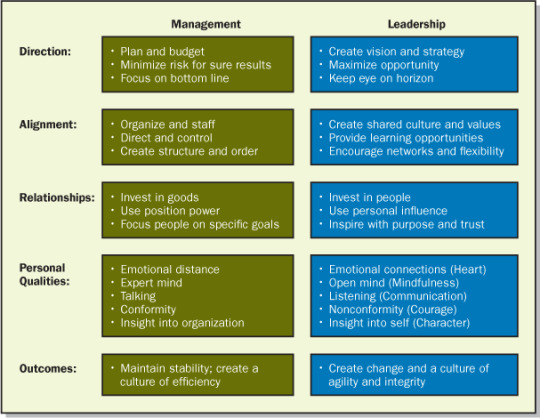
Daft, R. (2017). The Leadership Experience (7th ed., pp. Chapter 1). Boston, MA: Cengage Learning.
Sources: Based on John P. Kotter, A Force for Change: How Leadership Differs from Management (New York: The Free Press, 1990) and ideas in Kevin Cashman, “Lead with Energy,” Leadership Excellence (December 2010), p. 7; Henry Mintzberg, Managing (San Francisco: Berrett-Koehler, 2009); and Mike Maddock, “The One Talent That Makes Good Leaders Great,” Forbes (September 26, 2012), www.forbes.com/sites/mikemaddock/2012/09/26/the-one-talent-that-makes-good-leaders-great/ (accessed March 7, 2013).
1. Direction - where are we going
An MLec will plan well, making sure that all the course material is covered and budgeting enough semester time to the various material to be covered and tasks to be done. Risk minimisation might be done through the quality or quantity of work expected from students so as to optimally test their ability, transfer information, and achieve sure results. This could include a schedule to inundate students with information to ensure the tasks are handed in on time and that the tasks are done correctly. Part of this would be to make sure that as many students as possible pass the course and will be able to continue in the future, the focus on the bottom line or the low hanging fruit might mean that when assignments are marked, the basic rubric and formatting requirements are of equal importance as the actual thinking process and content evident.
An LLec, on the other hand, won’t just plan and budget, but create vision and strategy, through not only meeting the requirements of the course, but as my sociology lecturer said in first year “My job as a lecturer will only be done if you all become better citizens of your society”, vision transcends quarters and requirements, vision has to do with purpose. Strategy takes into account the future of students, being a lecturer that seeks to impart not only for the exam but so that the student will have added tools to their arsenal that will carry them forward in all their future endeavours and thereby add value in whichever context they find themselves. This includes maximising opportunities presented, so that where the students could be introduced to new contexts, ideas, where they have the ability to interact and to engage, as well as applying what they have learnt. There are some lecturers that have made part of their teaching opportunities to engage practically in what is being taught and to sometimes even emulate the real life contexts for which the students are preparing. This means that sometimes risks must be taken and a trust needs to form – although there is potential for disaster, your best students might only rise to the occasion when the stakes are more real, or when you are asking for heart, soul, and deep thought into the research paper, as opposed to churning out a textbook template. The orientation is different, for the LLec keeps their eyes on the horizon using all the knowledge and resources they possess to empower and nurture the growth of the truly bright and insightful students they believe in. Eyes-on-the-horizon stops academics and lecturers from becoming slack or lazy in their jobs and lets them continually apply themselves and seek to better themselves.
2. Alignment – what is most valuable and how should the group of people be organised
Lecturers naturally have a degree of organisation of people as a part of their job descriptions, namely the students and the various tutors. An MLec organises and staffs the classes accordingly, and assigns various tutors to the different classes so as to meet the need. The MLec also directs and controls the students and tutors so as to ensure the various work is covered and learnt, as tested through quizzes, assignments, and the like. Thus structure and order are created in the communication channels (forums, email, cell phones, consultation) and the first point of contact (tutors or directly to lecturers). The course is also structured and ordered according to the academic requirements stipulated, with due dates and extensive learning outcomes which must be achieved. The unit guide and tutorial manuals go to great lengths to ensure that students know how they are to interact within the course, and to what degree they are expected to interact with other students (such as group projects or class discussions, as well as the respective graded weighting on the various activities).
An LLec desires more from students, focusing on inspiring a culture of learning, of discovery and facilitating an interest through genuine passion. When the subject matter is made tangible, it begins to touch on key values of both the student and the LLec. Flexibility and understanding are the hallmarks of an excellent lecturer, where the priority is on the learning, and not the checkboxes. Learning has to occur beyond the lecture hall, and an LLec will provide opportunities for students to engage, an LLec is open to a degree and can build long lasting relationships with students and hopefully encourage students to build relationships with each other, possibly even bringing in other people so as to expand the network. Learning opportunities are provided at every opportunity possible, so that all the material is structured around the growth of the student, and not just covering the work. This, of course, ensures that long term, the information is hopefully retained and applied.
3. Relationships – the quality and utility of the relationships
Following on from alignment, if one is to view a unit as an organised collection of relationships, an MLec would look purely at the tasks and products, investing time and effort into the work and product of the class, how high the students score and the benefit and outcome for the MLec’s ratings. This may also mean that a quantity over quality approach might be taken, in which the MLec might feel as though they need to herd the students along and exercise the power of their position to ensure that deadlines are met and the content is adequate. The utility of relationships for the MLec is to meet the goals of deadlines and content produced that will satisfy the requirements, and this is done in a hierarchical fashion. (More likely to subscribe to Macgregor’s X)
While the work produced is important and the whole reason for this “organisation”, the LLec goes beyond this, investing in people in order that the quality of work produced is far superior because it contains authenticity. Investing in people over goods ensures that the people producing the goods are better satisfied – a happy and inspired student will produce far better work than a pressured student acting out of obligation. A difficult, but a key factor is using personal influence, this requires trust from both sides of the relationships but will inspire students and give them a line of sight to the eventual purpose of the work they are doing. Personal influence requires a greater level of engagement from the LLec and can be things such as: sharing personal experiences relating to the teaching; paying attention to where the students are at; being humble and down to earth but without trying too hard to be liked or to be a peer.
4. Personal Qualities – the magic formula for truly reaching people
All the qualities the MLec should have are necessary, regardless, but they are not complete or comprehensive enough. Along with the hierarchical approach to relationships comes an emotional distance, which leaves the student unable to ever truly engage with what is being taught. A clear knowledge of what is being taught is necessary, but this is often when MLec’s stop as they don’t go beyond reading academically complex paragraphs and therefore run the risk of alienating the class from the subject material. An expert mind is a wonderful thing to have, but if it is not translatable, it is useless. An MLec can often get caught up in their knowledge and therefore do a lot of talking, which is good in that talking is needed to give instructions and to relay subject material, but again, it runs the risk of assuming that students understand and if they do not, it is their own failure to apply themselves. Conformity is a personal value of the MLec, and while abiding by the rules is not inherently bad, conformity in a learning environment is detrimental to the very object of the experience. Being able to reach students in a way that they can truly understand requires more than just saying facts. In fact, one could go as far as to say that a conformist has no place in the scientific or academic sphere, as the very nature of it requires questioning, open-mindedness, and a desire to learn and grow. Insight into the systems and structures of the university as well as the field of studying is a very helpful quality to have and will be of immense value to the instruction of students, but it is surface level and not enough.
The LLec needs to communicate heart and soul in what they say; anything will be listened to more, understood better, remembered on a deeper level when taught through emotional connection. The LLec that understand this will help to foster an emotional connection between the subject matter and the student which will make their job all the more easier. While adequate knowledge is required, keeping an open mind, paying attention to detail, constantly learning and keeping up with current research as well as being open to the possibility that a student might have some insight and may be a source of learning is one of the most powerful qualities an LLec can ever have. The moment one loses one ability to learn from anything and everything, one ceases to grow. With the relational understanding that the LLec has, there should be open channels of communication created as a good reception and evaluation of (listening to) constant feedback will immensely increase effectiveness and efficiency within the learning process. An LLec has courage, courage to participate in discussion and courage to disagree with what is not right, even if it is the norm – times in history such as when bad leaders have been celebrated or when eugenics was a popular science might not have had as terrible effect if there were more LLecs that taught the theories and had the courage to speak out against them. Conforming hinders critical thinking which is paramount to effectively teaching in a university setting. And as much as the LLec should understand the context of the unit, they should strive to understand themselves and how they work. This insight will ensure that the course is set up so as to maximise strengths and minimise personal weaknesses, thereby enhancing the education experience of LLec and student.
5. Outcomes – what will come of these two approaches
The MLec will maintain stability, as there might be a very predictable trend of the course content produced as well as the marks of the students being similar or averaged over time. the culture of efficiency might mean that more students complete their work and mostly meet the required standards for the course and therefore get through without to much hassle.
The LLec will seek to make an impactful change in the university and in the student’s person. This, of course, requires a personal investment from both sides. The change will be for the good and thereby benefit society as a whole. A culture of agility and integrity will set students ford continue learning and application based on the course/unit, and this being done with a commitment to authenticity and ethical living as learning and academics are not viewed separately or distant from life and living and who they are as people. The LLec inspires the student to be more and to be better.
As a teacher, I know how difficult it is to keep to this all the time, and I do try and I do also need to try harder, but I’m convinced that it comes with practice, applying oneself and staying teachable. Of the lecturers I’ve had that have embodied the archetypal LLec, one quote stands out as profound:
“I have done my job as a lecturer if when you complete this unit, you have become better members of society” (Dr Alex Asakatikpi - Introduction to Sociology)
0 notes